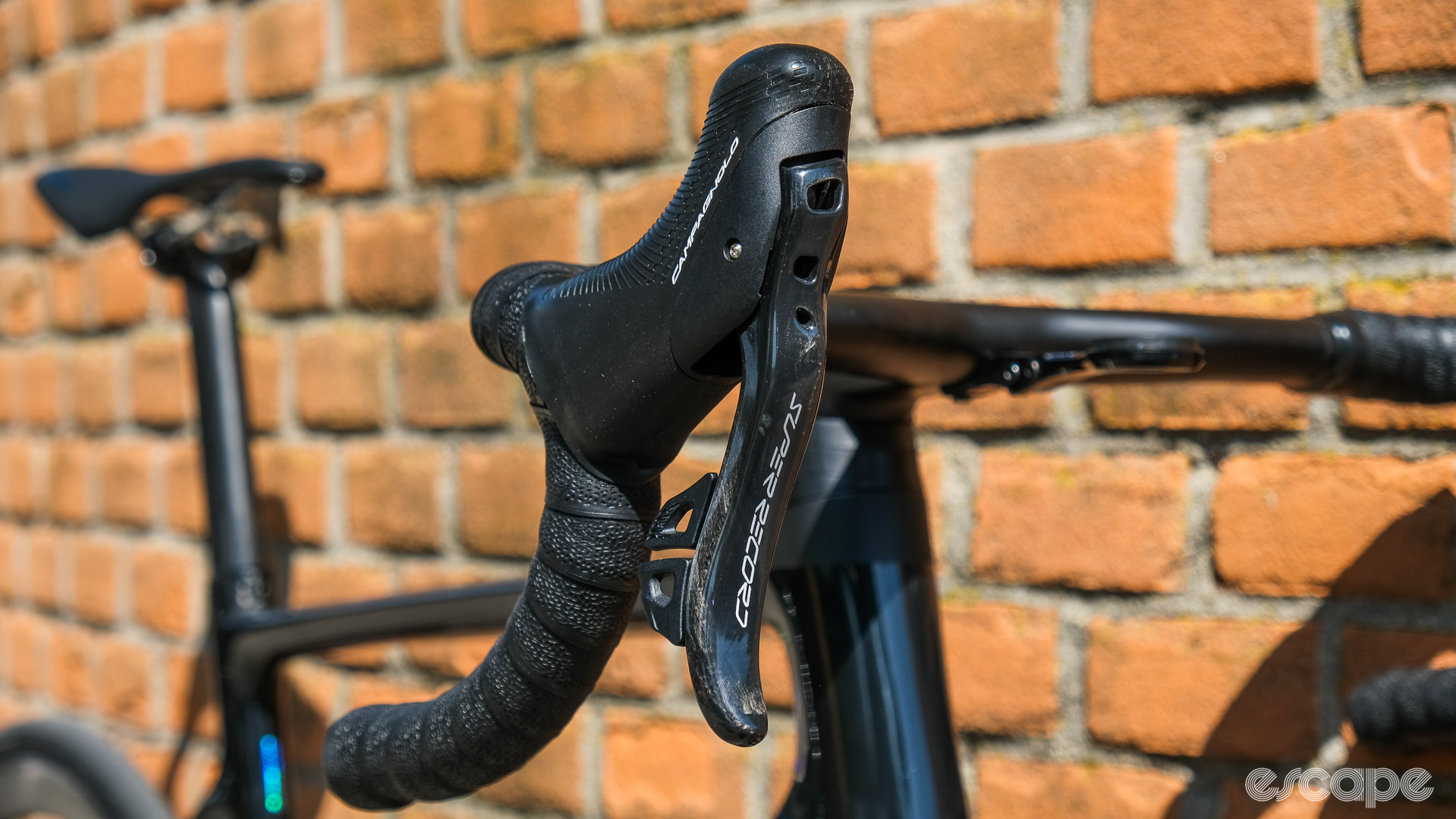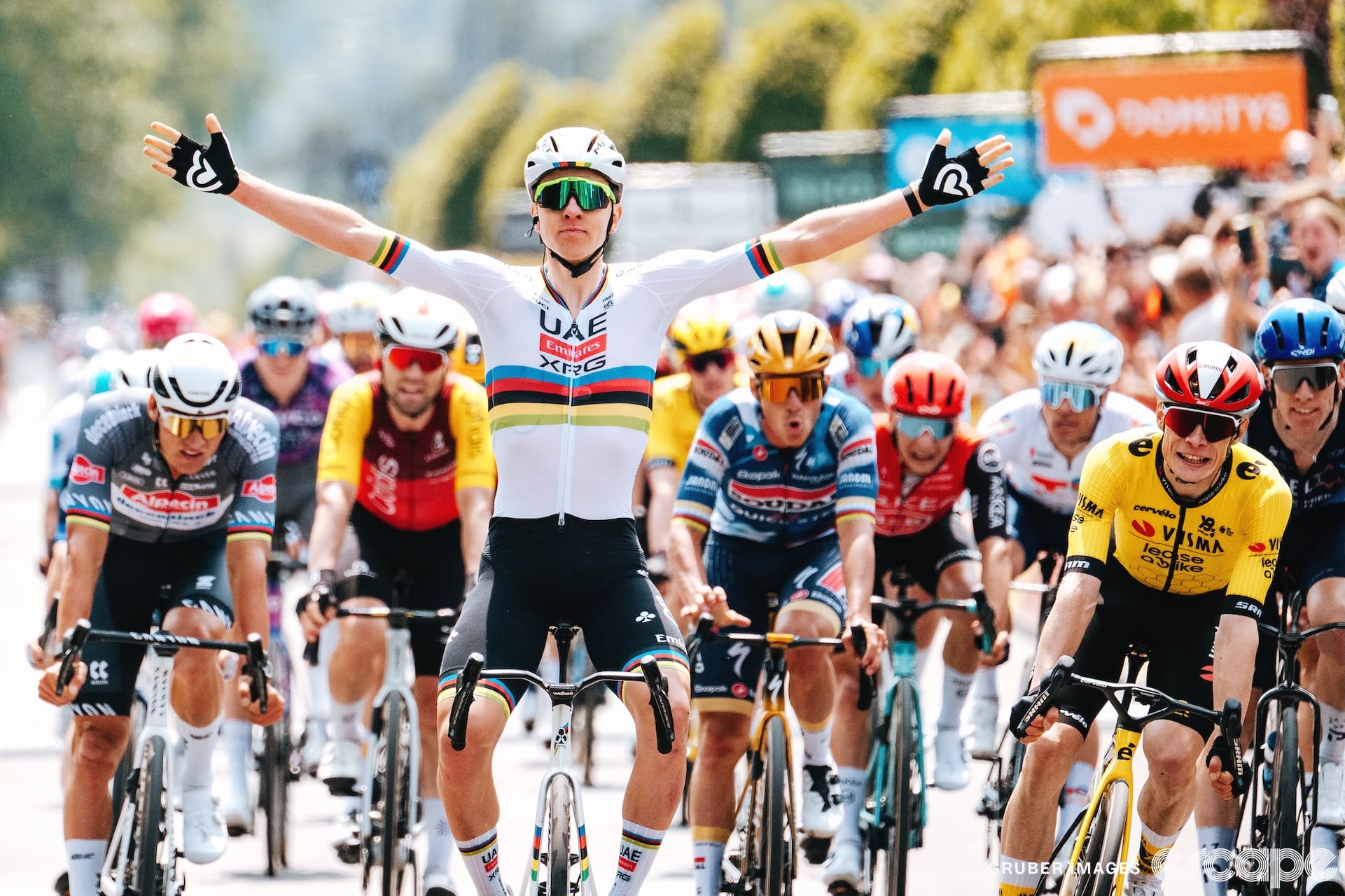Campagnolo has a new Super Record 12-speed electronic groupset. The storied Italian manufacturer has ditched its EPS wired-electronic design in favour of a new, entirely wireless offering. Rumours Campagnolo had ditched the thumb shifter in favour of a new stacked shifter button design have proved accurate, but those headline stats are only part of the story.
Campagnolo has a new gearing philosophy with three new, closer ratio 12-speed cassette options, all with ten-tooth sprockets. Up front, Campy has three smaller chainring combinations to choose from. The new philosophy leaves no room for a 1X offering, and there's also no power meter right now. There is, however, a new MyCampy 3.0 app offering improved interaction with the wireless groupset. But it's another sad day for rim brake aficionados, as this new wireless groupset is disc brake only.
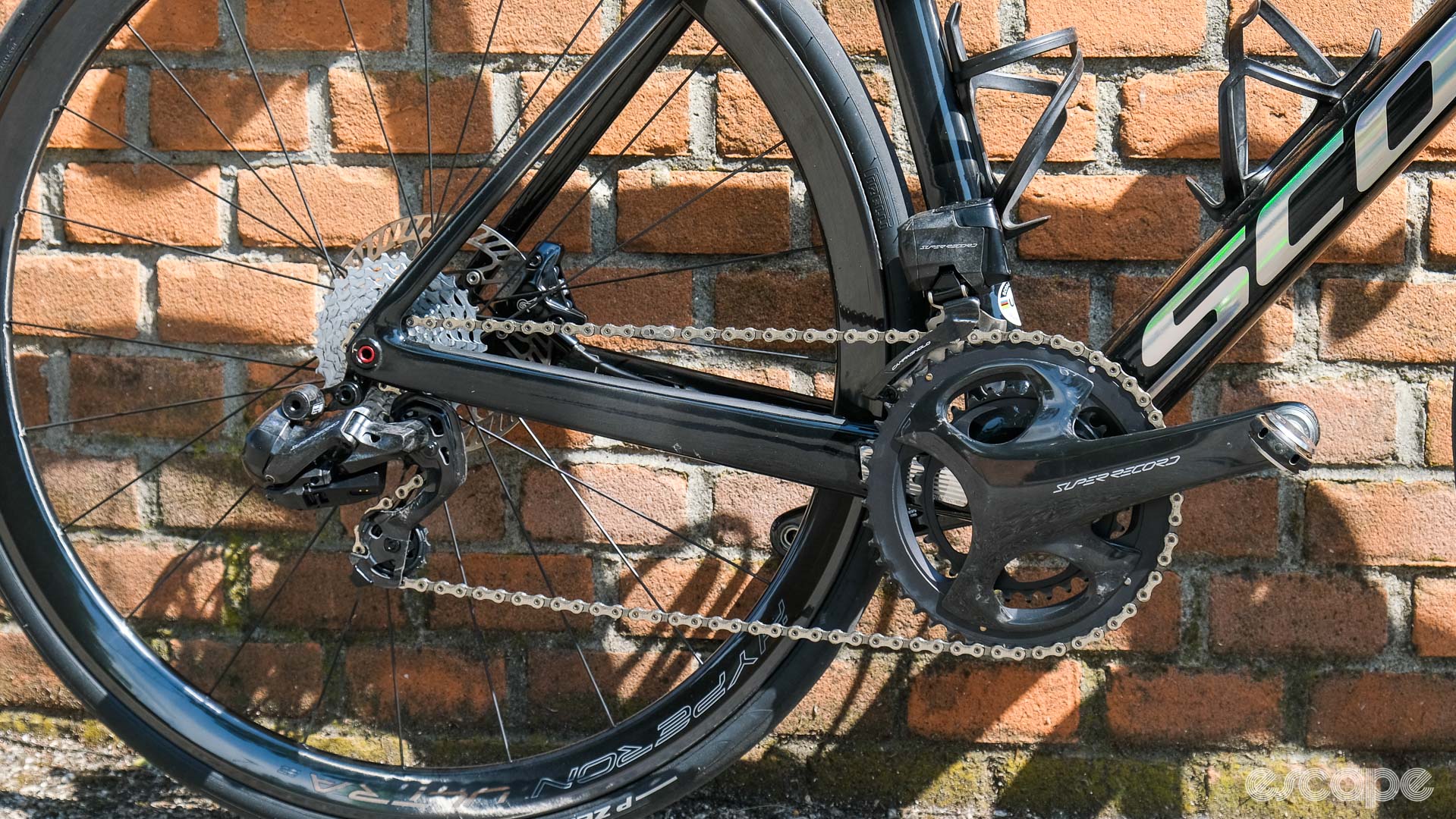
All that considered, perhaps the most striking thing about the new groupset is the jaw-dropping price tag. With many speculating that this new groupset could prove a "make or break" moment for the heritage brand's future, Escape Collective was on the ground at the media launch in Vicenza, Italy, last week to get a feel for what €5,200 (US$5,399 / ~AU$8,500) worth of groupset feels like.
What follows is a deep dive into everything about the Campagnolo Super Record Wireless, a discussion on what the groupset means for the brand's future, and our initial impressions after a 40 km ride on the new kit.
Good stuff: Hood ergonomics. Far simpler to install and setup than previous EPS. No new tools are required.
Bad stuff: The price. Campagnolo's iconic thumb shifter is no longer. There's no obvious path for 1x compatibility. Currently no power meter option. No more rim brakes. Smaller cog sizes aren't ideal for watt-weenies.
Fully wireless
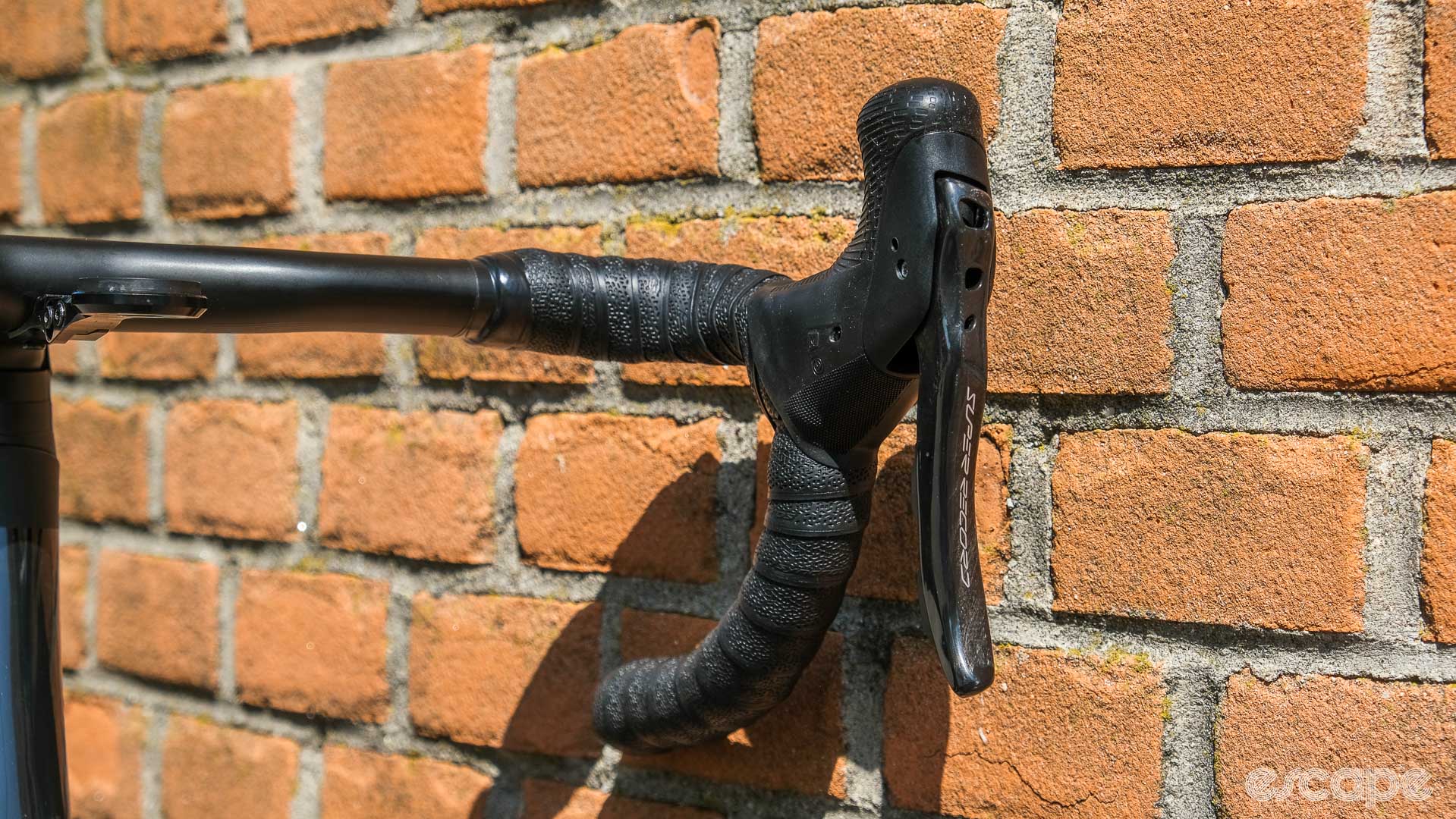
After more than a decade and four different versions of its wired EPS electronic groupset offerings, Campagnolo has finally unveiled its entirely wireless new Super Record groupset. The new groupset features bluetooth connected wireless shifters which pair to wireless front and rear derailleurs, each with their own battery for a truly wireless system. Campagnolo continually referred to a rider-centric approach in designing the new groupset, and says the wireless system offers a simplified install process – no arguments there – and improved shifting with simplified charging for the end user.
Gone is the Campagnolo Power Unit (read: battery) with its non-removable wires, and replacing it are the new "Energy Hubs" (read: batteries), one in each derailleur. Interestingly, the batteries are specific to each derailleur and cannot be swapped back and forth à la SRAM AXS batteries. Campagnolo spoke of the difficulty in navigating all the patents owned by competitors several times during the presentation, with the different front and rear batteries specifically mentioned as one way of circumventing SRAM's wireless and derailleur-mounted battery patents.
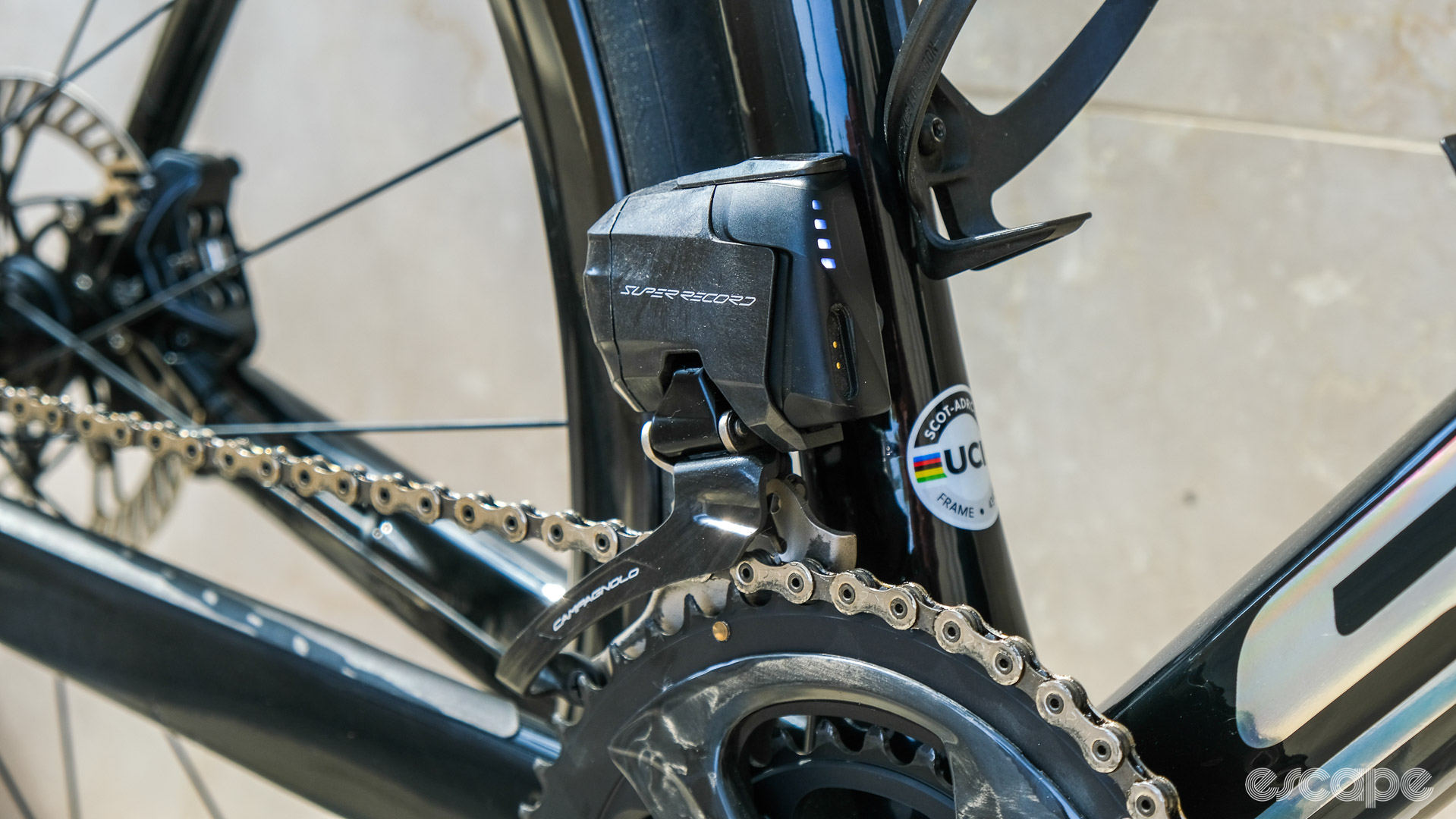
The new batteries offer derailleur-mounted charging with a magnetic cable and off-bike charging through a USB charging cradle. Charge time is less than one hour for a full charge, but the non-linear charge process means the batteries are already 20% charged after just ten minutes and 90% charged after 45 minutes.
Campagnolo claims a full charge offers a 750-1,000 km range but couldn't put a shift count on that range, presumably due to the extra power required for a front shift versus a rear. That 1,000km is comparable to the claimed range with 12-speed Di2, while SRAM claims around 60 hours of run time with its AXS batteries.
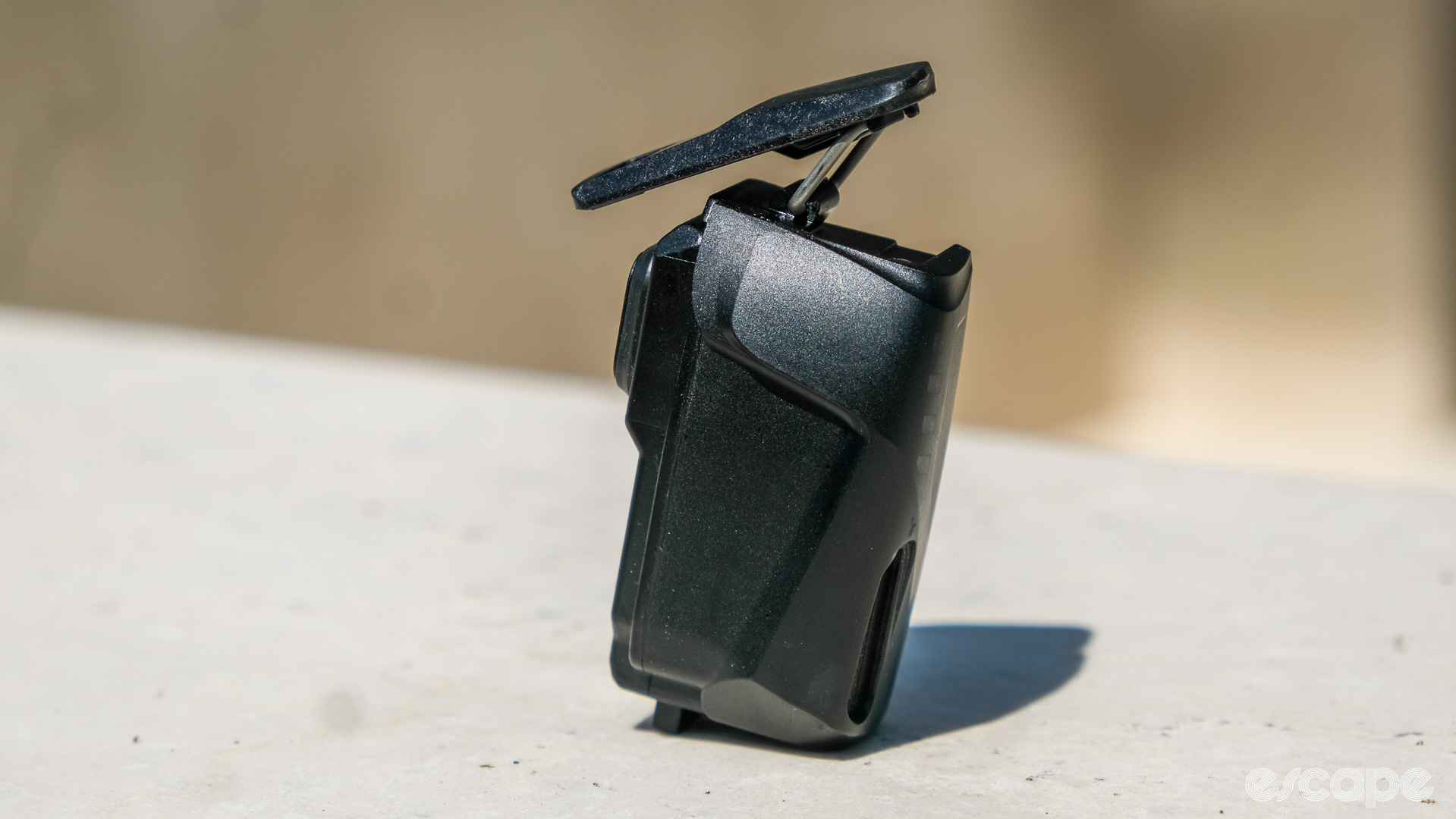
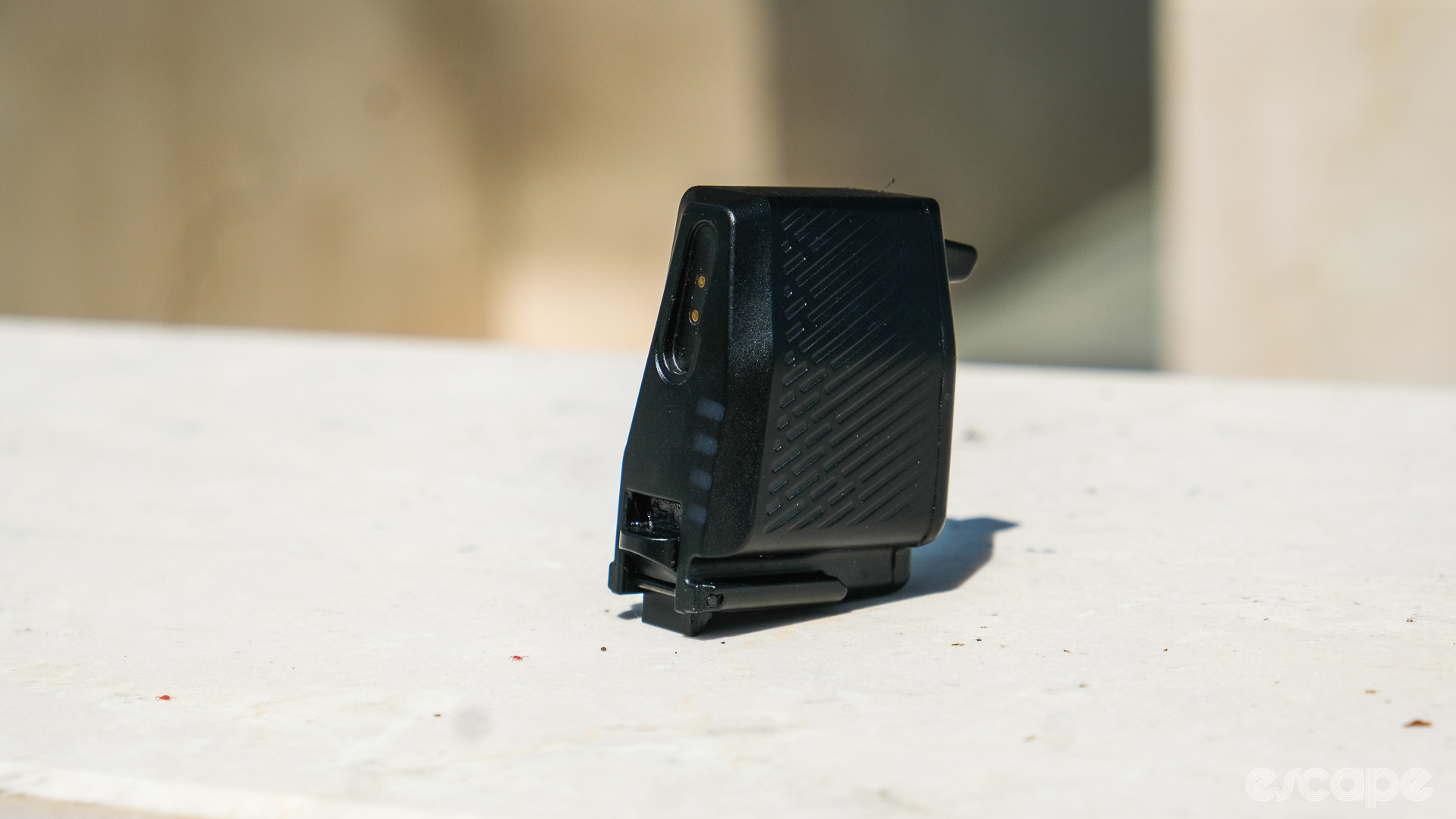
Up front, the new shifters run on CR 2032 coin cell batteries, which should last anywhere from 18 months to two years, depending on usage. More on the new shifters in a bit.
The new wireless derailleurs have understandably bulked up with the inclusion of a battery in each. The increased size is most evident with the front derailleur, which has grown considerably longer (front to rear) with the inclusion of the new front-facing battery and ring-pull-can-like release mechanism.
Despite its extra bulk, the new front derailleur still offers plenty of rear tyre clearance. Campagnolo was reluctant to give exact figures – understandably so, given the influence of frame design on derailleur placement and hence tyre clearance. That said, conservatively speaking, Campagnolo is confident the new derailleur will clear at least a 34 mm tyre on a road-like 410 mm chain stay frame.
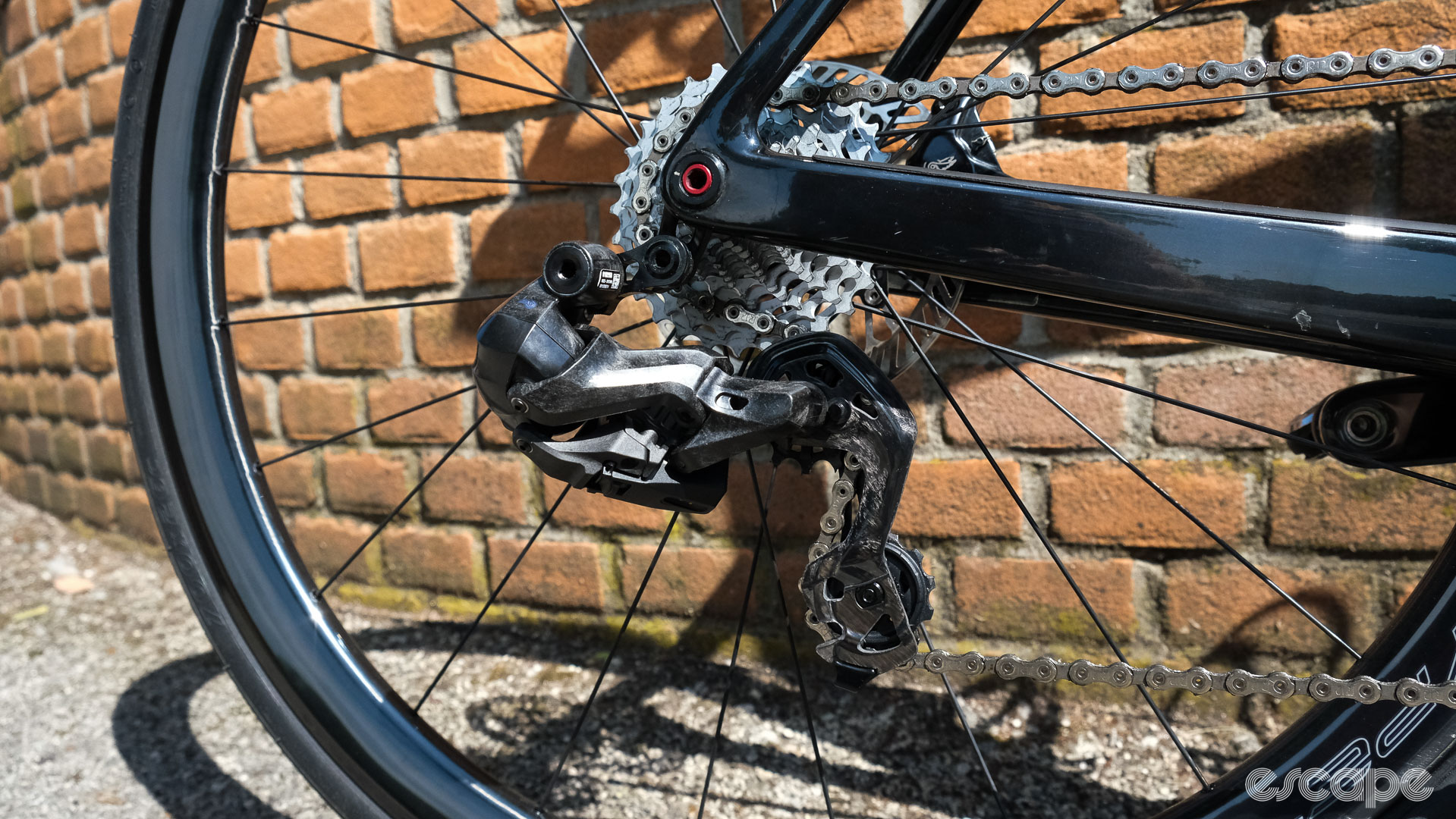
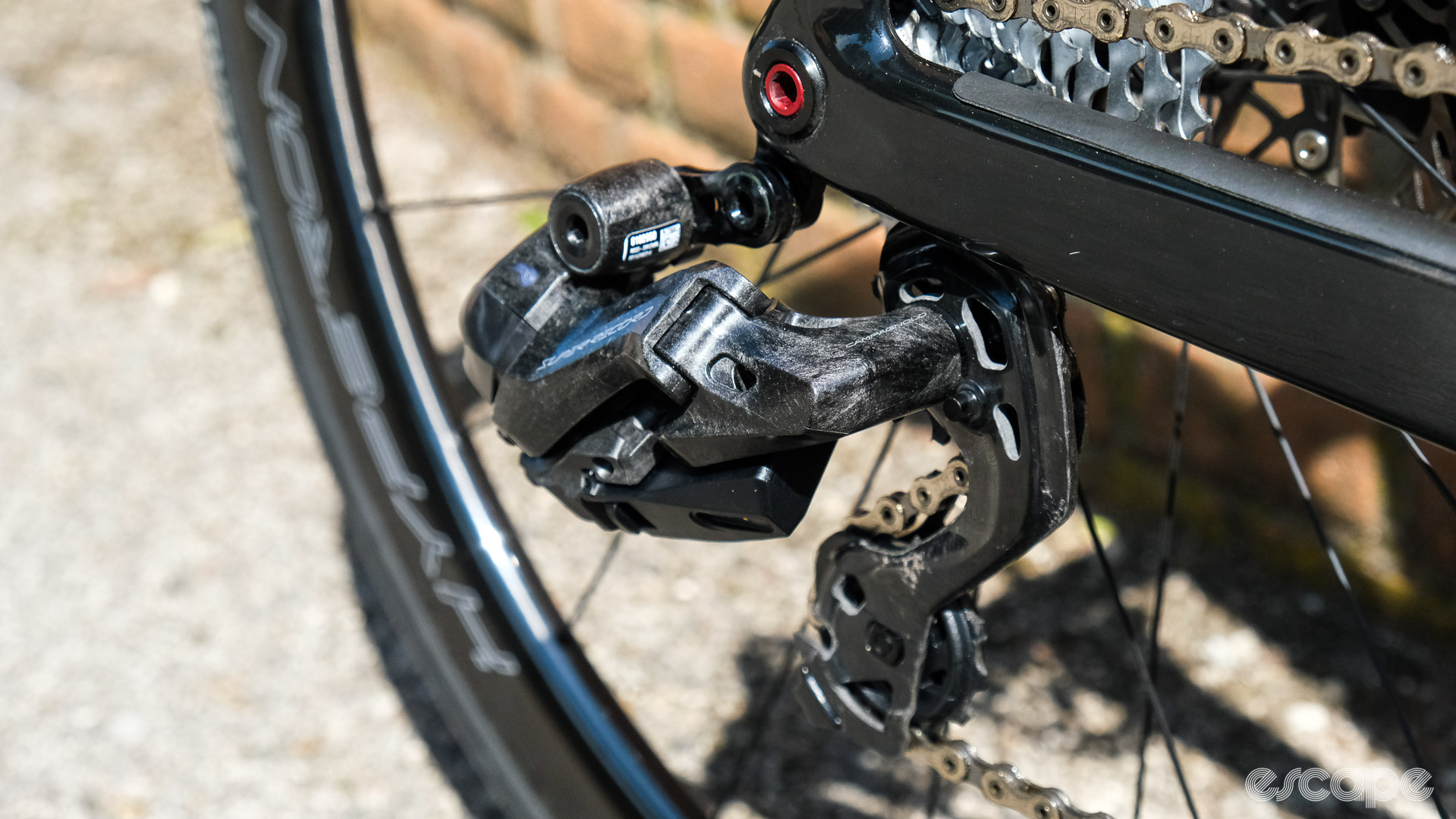
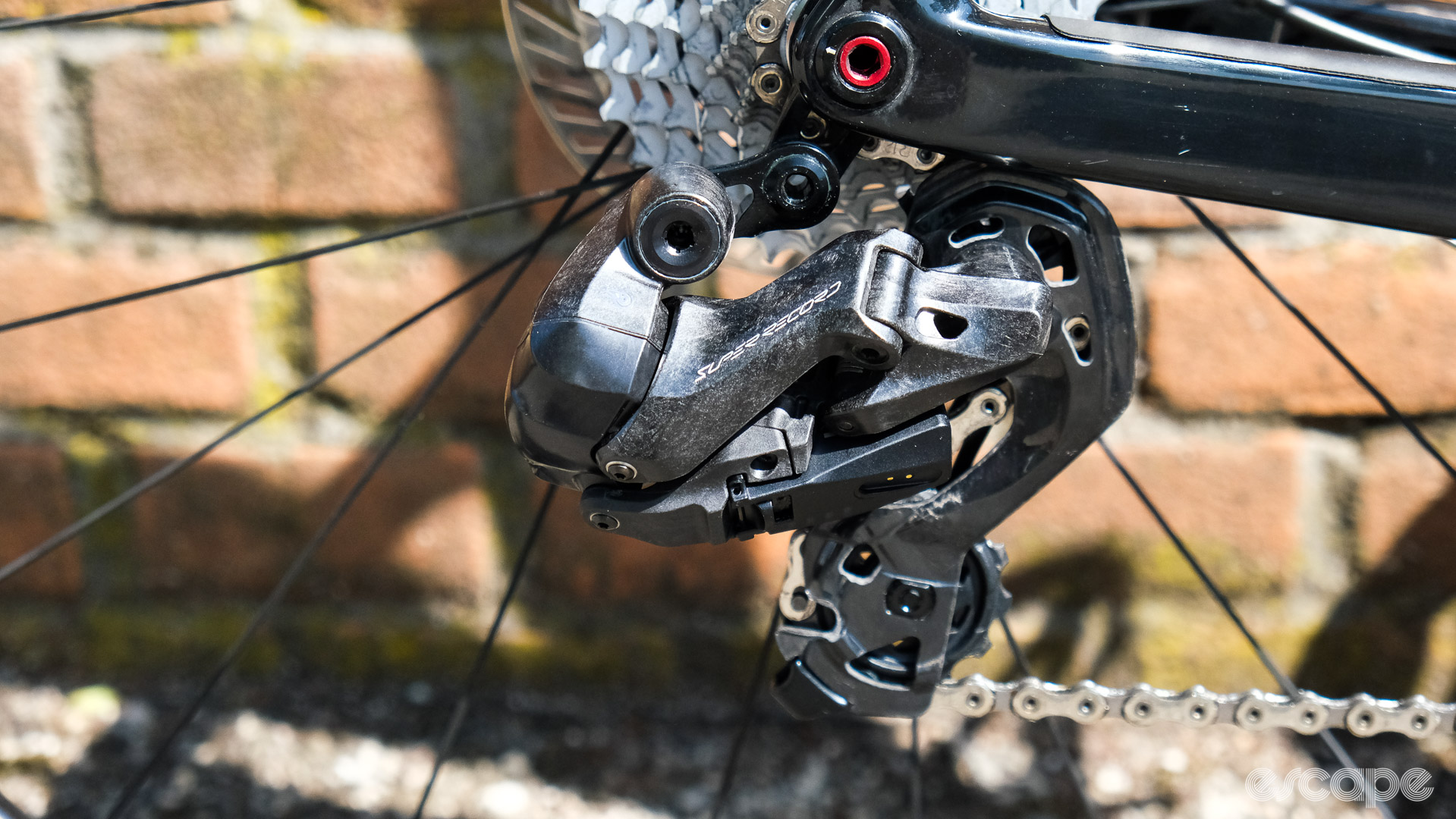
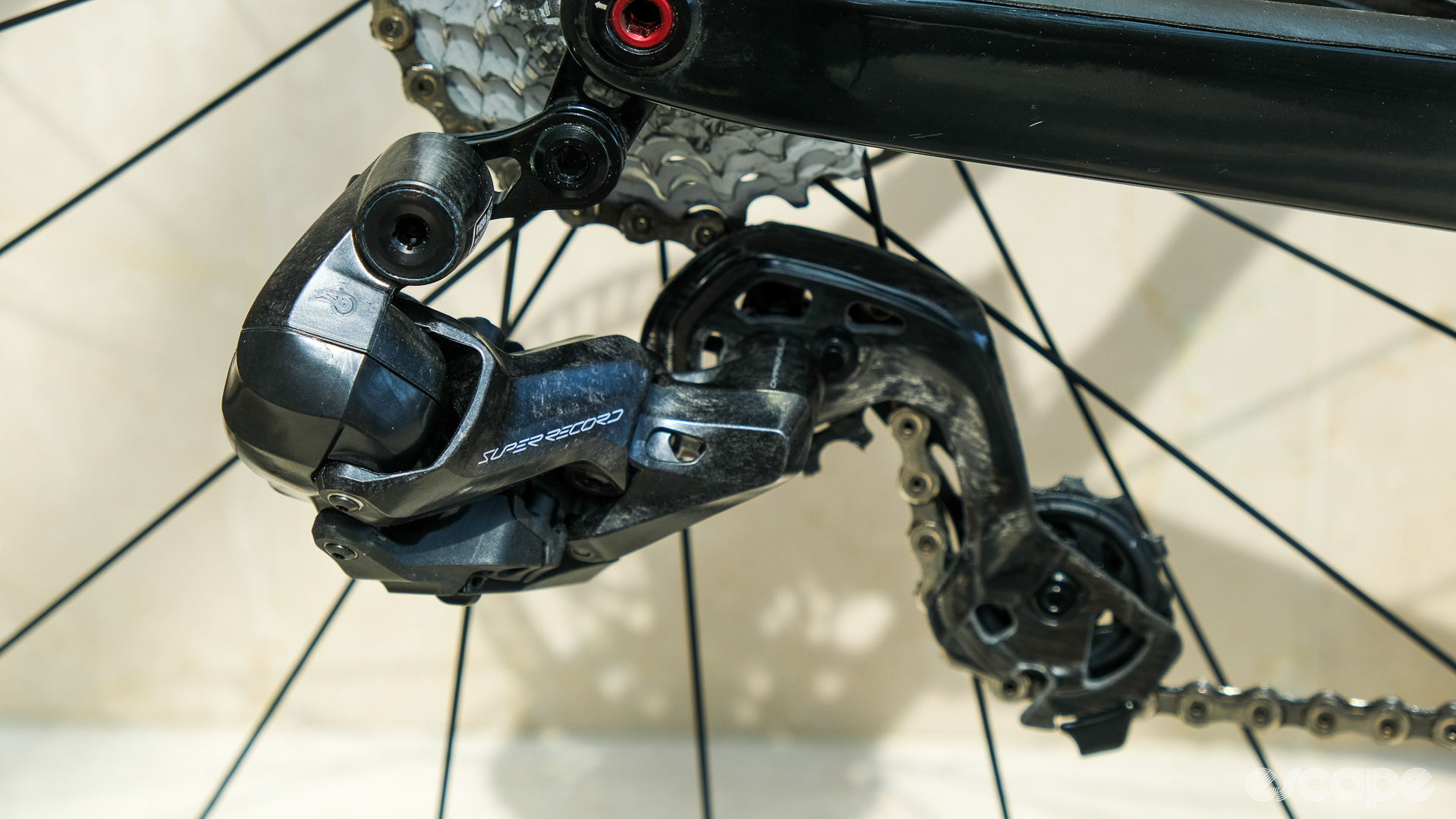
The new rear derailleur does a better job of hiding the battery at the rear and inside of the new mech. That said, it's still a considerably large piece of kit, as far as rear derailleurs go – but it does at least offer sweeping and curving lines throughout, matched to fantastically intricate carbon finish structures, especially on the pulley cage.
Campagnolo has not included any form of clutch in the rear derailleur, reinforcing the intention this is a road-focused groupset. There is however a disengagement mechanism to protect the derailleur in the event of a crash or strike of some sort. As the name suggests, the disengagement mechanism disengages the rear derailleur to help absorb any impact and prevent further damage by restricting how far the derailleur can shift up or down the cassette. The mode can be disengaged using the shifter buttons, but often requires a manual reset by manoeuvring the derailleur back into position by hand.
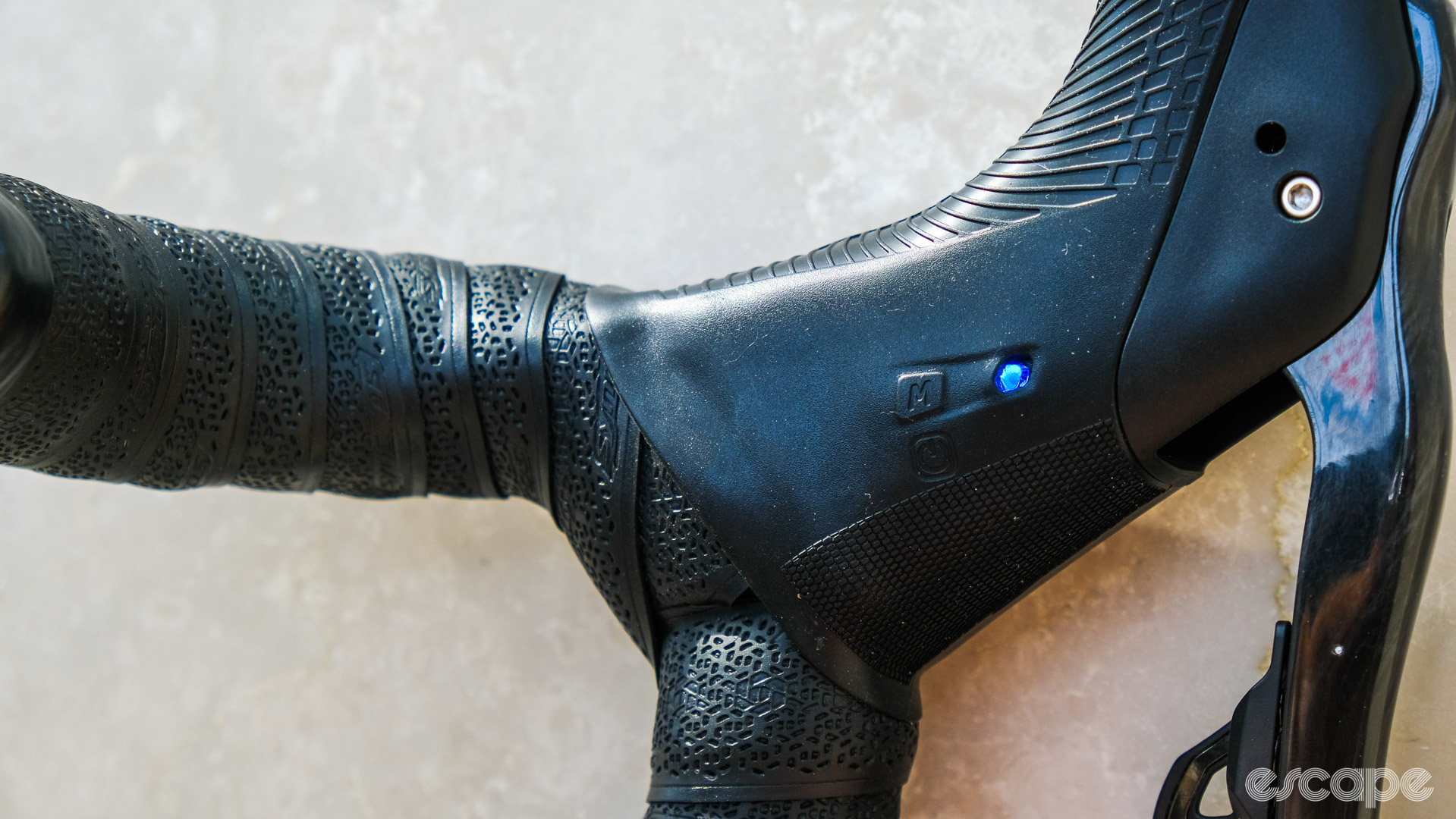
Both derailleurs now house an LED battery level indicator and a separate LED Campagnolo angel wing logo to display the connection status. Unlike Shimano Di2 and more akin to SRAM AXS, the new Super Record Wireless wakes on sensing any movement and is shift-ready almost instantly, requiring no shifter-clicking to get going. The new wireless groupset will go into sleep mode after 30 minutes of inactivity, but in a neat addition, the shifter body and hoods now feature an on/off button, where the thumb shifter traditionally sat, for travelling, meaning a long car or plane journey is not unnecessarily draining the shifter batteries. A big improvement over the magnetic strap required to turn off the previous EPS groupsets.
The entire system is rated IP69K waterproof. IP69K is the highest international rating on the ingress protection scale. The scale provides a rating based on a product's ability to withstand solids and liquid ingress. The test subjects products to high-pressure (1,160 to 1,450 PSI/80 to 100 bar), high-temperature (80°C/176°F), 14-16 L/min spray from just four to six inches at four different angles for 30 seconds at a time. Basically, it's a tough test, and the new groupset has achieved the top rating. That said, this is not a license for Super Record Wireless owners to power-hose their new group sets. While the rating suggests the groupset electronics will hold up to such intense cleaning, the bearings and other elements of the bike may not.
The same, but different?
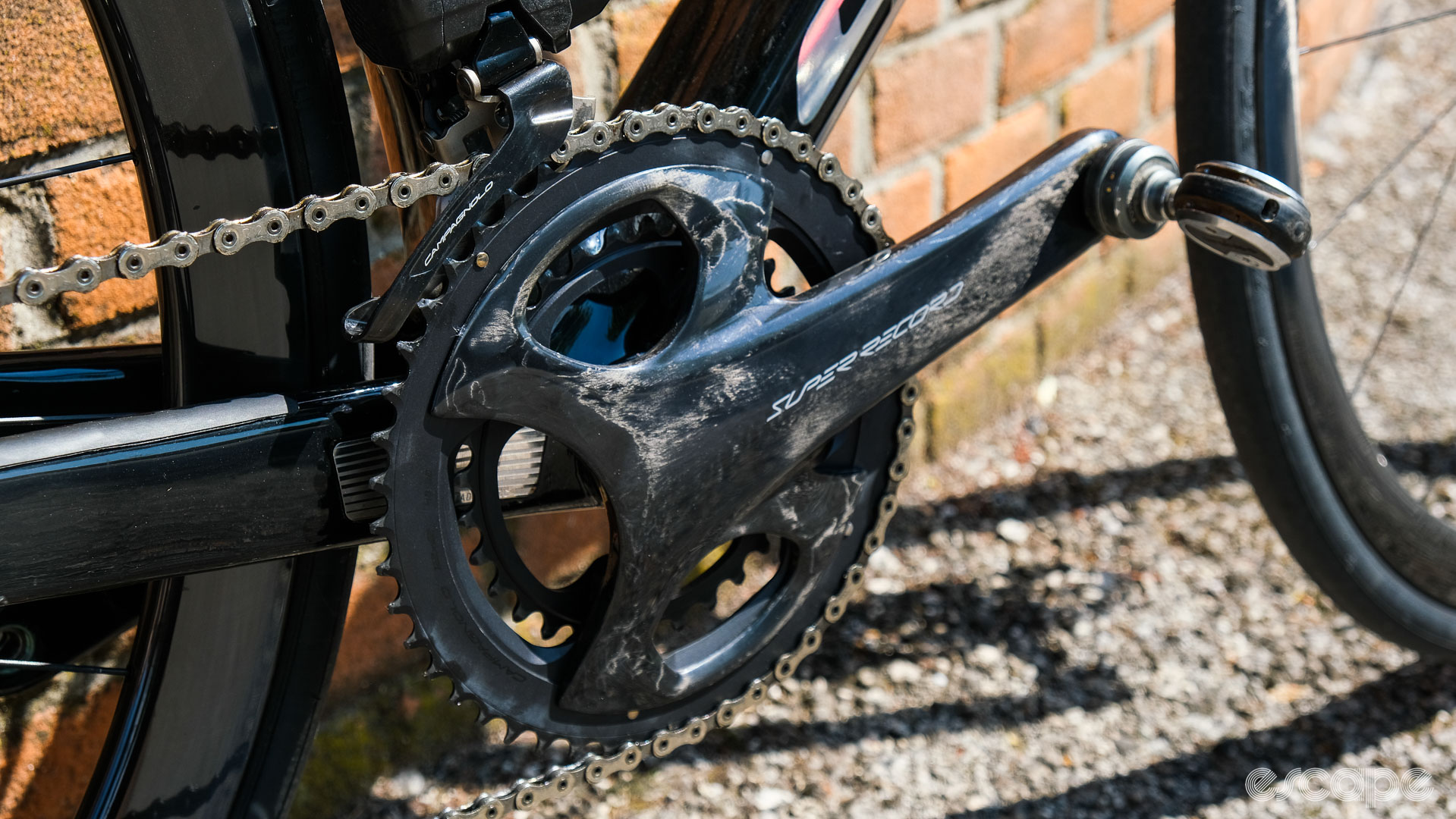
There are a few givens with new premium end Campagnolo groupsets. A new Campy group will look flash, cost a small fortune, and bring some form of step change innovation. Think first to 10, 11, 12 & 13 speed.
There's arguably no headline step change this time, though. While the new SRW certainly keeps up appearances with its carbon finish, curvy lines, and astronomical price tag, wireless shifting and wider gear ranges with smaller chainrings and sprockets are not new. Campagnolo even admitted that some might see similarities between its new groupset and existing offerings from other manufacturers.
That said, Campagnolo were adamant the new groupset offers a "big step forward for the industry" and genuine innovation, providing a much more dynamic and improved riding experience. The goal with the new groupset, as Campag explains it, was to increase the overall range while also moving to a closer ratio cassette and sticking with 12 sprockets. Or in other words, having cake and eating it.
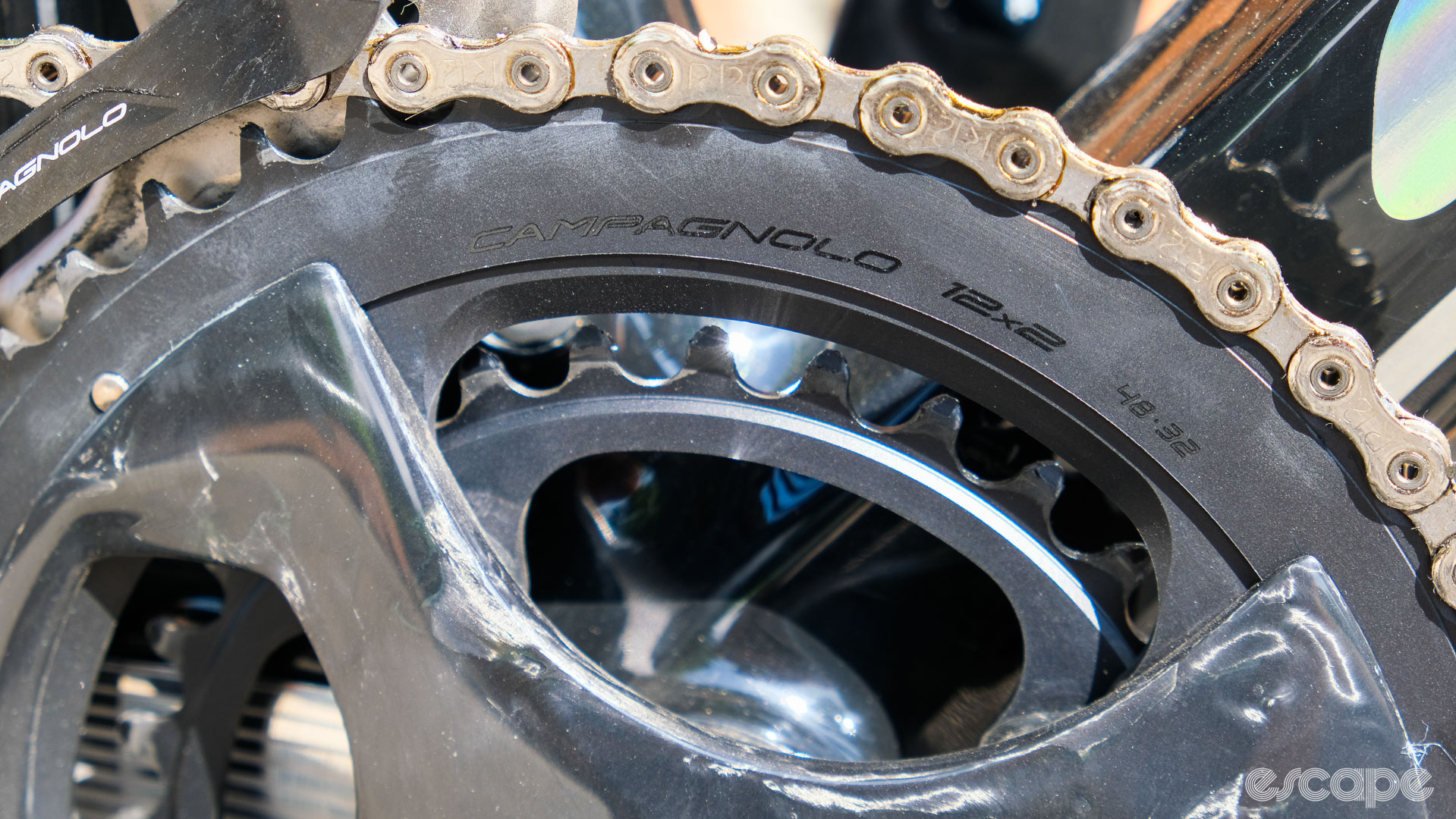
To achieve this, Campagnolo is now offering 50:34, 48:32, and even a 45:29 chainring combination up front. Out back, the 16-tooth jump in chainring sizes through the range is contrasted by the 10-25, 10-27, and 10-29 cassettes with Campagnolo focusing on reducing the jump between sprockets. To achieve this, the brand has included more single-tooth jumps within those cassettes and minimising the jump to just two and three teeth between the biggest sprockets.
It's these ratios, designed from a "rider-centric" approach, that Campagnolo claims set it apart from what currently exists. The result, according to Campagnolo, is the "perfect cadence" all the time with "superior shifting precision" and a wider range than the company has previously offered. The ratios are different, but the concept is hardly new.
There are of course other ways to increase gear range, but as Campagnolo sees it, cassettes with larger jumps between sprockets negatively impact the riding experience. It's a familiar line: Campagnolo touted the close ratios and smaller jumps between sprockets when it first moved to 12 speed five years ago. Back then, Campagnolo was responding to the demands for wider range cassettes, cognisant of the fact it wanted to avoid introducing jumps it considered too large. To achieve this the brand moved from 11 speed to 12. The result was an 11-29 and 11-32 cassette offering, while Campagnolo stuck with the 53:39, 52:36, and 50:34 chainring combinations at the front.
This time Campagnolo has stuck with 12 sprockets, but increased the overall range with two entirely new chainring combinations, 48:32, and 45:29, and a ten tooth sprocket without resorting to the larger jumps between sprockets at the rear.
These closer ratio cassettes and the reliance on the greater range at the front, means there is no 1X option from Campagnolo at this time, and the classic 53:39 has disappeared entirely from the new range. In return, riders have the choice, at least at the point of purchase, to opt for anything from a 1:1 gear ratio at the rear, right the way up to the equivalent of a 55:11 in old money with the new 50:10.
Furthermore, given Campagnolo has decreased the BCD on the new Super Record crankset, it is bad news for those hoping for cross compatibility with the existing EPS 12 speed 53:39 chainrings. Campagnolo admitted that both the existing cassettes and chainrings are technically compatible with the new groupset but repeatedly warned that mismatched new and old components will result in 1) decreased performance and 2) less optimal ratios. In fact, the existing 12 speed derailleur is entirely incompatible with the new 10:25 cassette.
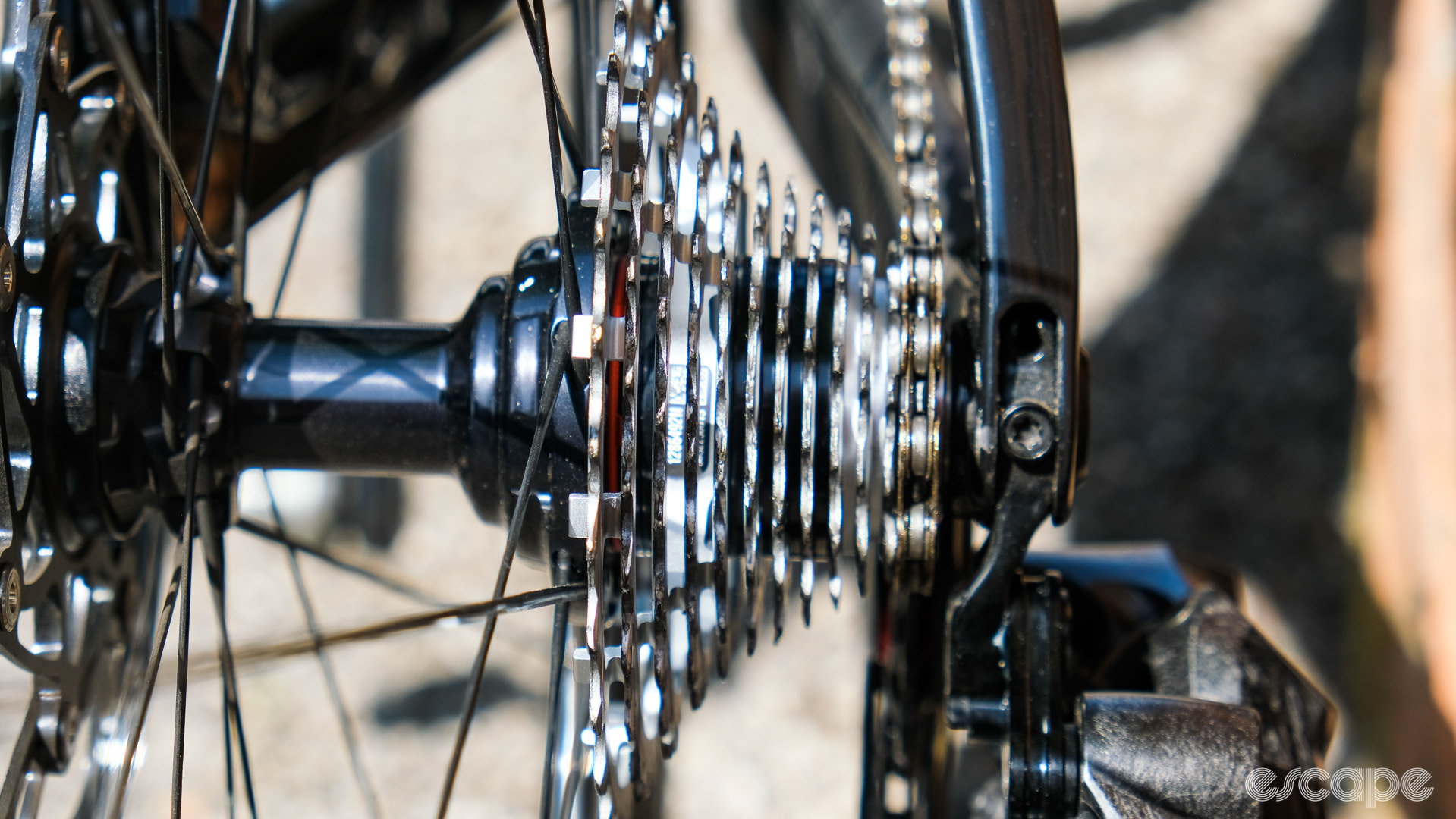
Sticking with cross-compatibility, the new cassettes are only compatible with Campagnolo's new N3W freehub body. That's less prohibitive than it may sound – with more than 50 wheel manufacturers around the globe currently offering the N3W freehub, that should be fine for most. To improve stiffness and decrease overall weight, the 10, 11, and 12 sprockets are one piece (à la Ekar) the middle sprockets are made individually, while the top five sprockets are again one piece.
For all the talk of "perfect cadence" and wider "metres of development", one has to imagine pro-only chainrings must be in the works – possibly 54:38 – for Campagnolo's sole-surviving WorldTeam (AG2R-Citroën) and ProTeams, or perhaps we could see Campy riders racing the new groupset with the current 53:39 and 11-29/32 cassettes.
Smaller sprockets paired with smaller chainrings comes at the expense of increased drivetrain drag. This is especially the case with smaller nine and ten tooth sprockets, and Campagnolo didn't shy away from such concerns when Escape asked the question on drivetrain efficiency. Campag freely admitted the smaller chainrings might not prove optimal in some high performance scenarios, such as WorldTour sprinting, but were confident the tradeoff in drivetrain efficiency was more than outweighed by the overall experience for the majority of riders.
That's a take I tend to agree with. When outright performance matters and every watt counts – think time trials and hill climbs – I prefer larger chainring and sprocket combos. But for general riding on varied terrain, I appreciate the benefits of smaller combinations and closer ratios.
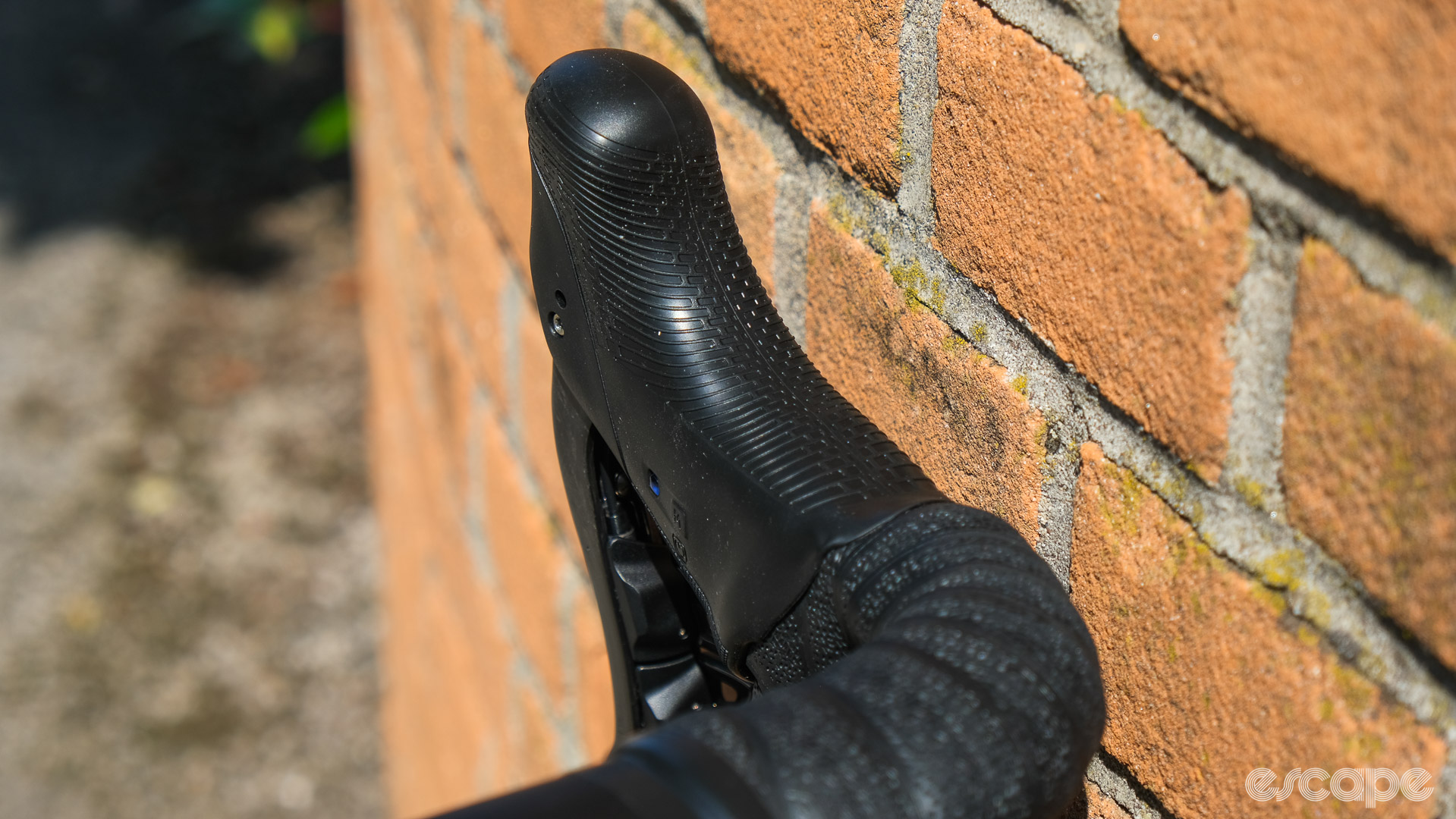
Campag shifters sans thumb shifter
Speaking of shifters, Campagnolo has refined its hood and lever design for improved ergonomics. If I'm honest, I can't help but smile as manufacturers speak of improved ergonomics with each new groupset launch, as if human hands are evolving that quickly. That said, the new SRW levers are arguably the biggest update to any of the three major players' designs since the introduction of electronic shifting.
As mentioned earlier, gone is the Campag thumb shifter, replaced with the new stacked, two-button interface behind the brake lever. The "one button, one function" buttons are entirely customisable through the new MyCampy app, offering riders the option to configure their shifting controls however they prefer. The stacked design is visually akin to the FSA WE shifter rocker plate shifter buttons, but Campag's take separates and enlarges the buttons.

Love it or hate it, the thumb shifter was segmenting the market. We feel the new design will suit everyone.
Campagnolo on the passing of the thumb shifter.
Seemingly, most people consider the terms "thumb shifter" and "ergonomics" as an oxymoron. The new ErgoPower shifter design, ditching the thumb shifter, is entirely in response to market demand, Campagnolo explained. The brand openly admitted the thumb shifter design was quite polarising and claims the new twin button design should suit everyone.
The hoods are now longer and wider than their older 12-speed EPS siblings, despite the overall size and height of the new shifters actually decreasing slightly. In addition to those larger hoods, the upper contact surface now features a more gradual ramp from rear to front and an almost squared-off shape compared to the sweeping lines and almost elbow-like ramp of the outgoing hoods.
The new shifters retain the Super Record shifter's instantly recognisable cutouts on the brake lever and new shifter buttons. Not just some minuscule weight saving or a homage to the drillium of yesteryear, at least one of these holes serves a specific purpose. As with many levers currently available, the new SRW levers include reach adjustment. Unlike others, though, the reach adjustment screw is easily accessible through the lowermost of these three holes on the front of the brake lever.
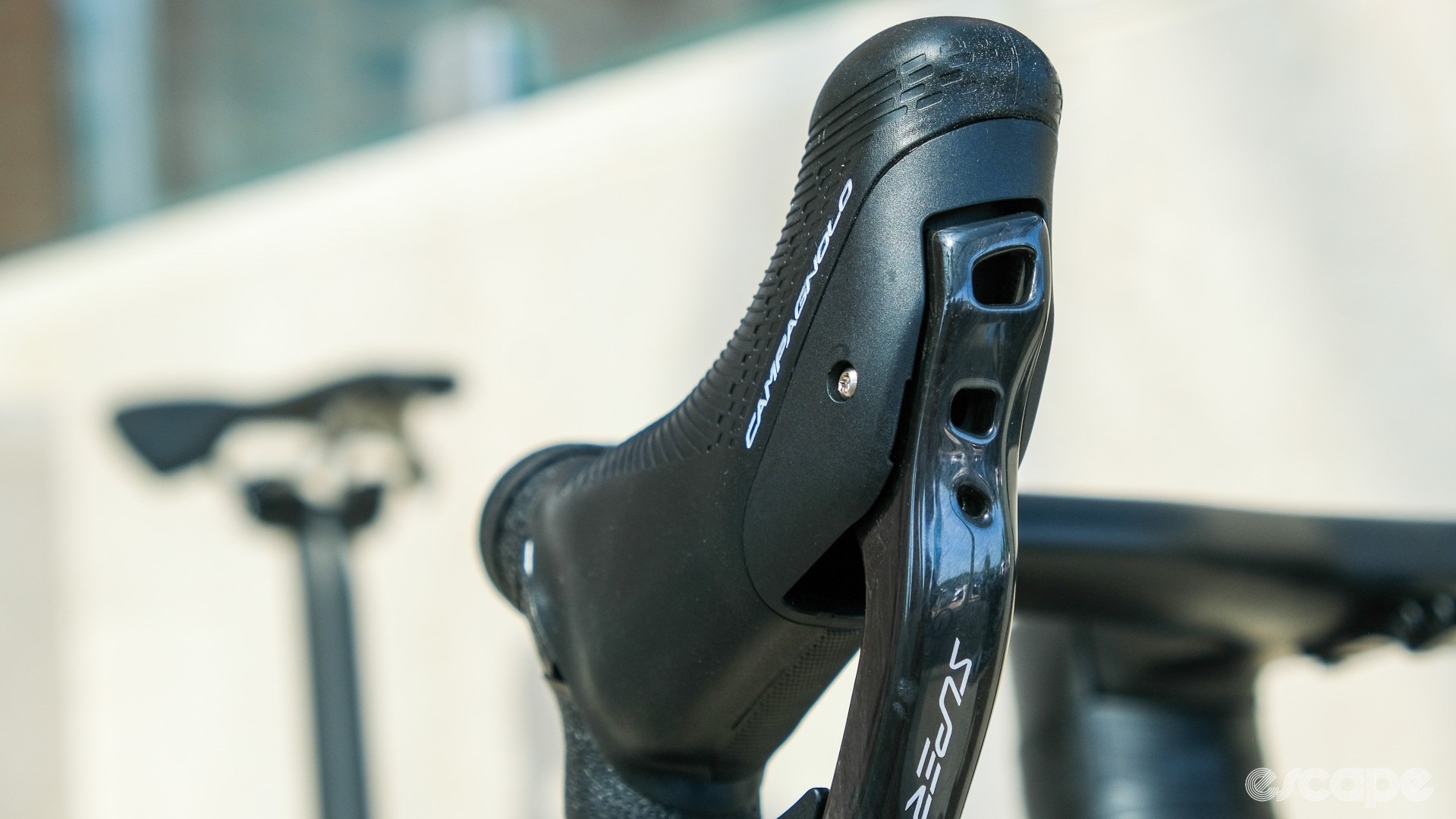
However, fans of brake lever contact point adjustments – which the manufacturers claim are few and far between –will be left disappointed as the new levers offer no such adjustment.
Next to that on/off button mentioned earlier is a mode button on each shifter body. The mode button is used during initial setup but also offers head unit control with Bluetooth-connected head units, like the magic buttons on Di2. There's also an LED in the shifter body which blinks to indicate connection status and battery level.
A final note on shifting: while not quite ready yet, Campagnolo promises it has "satellite shifters" in the works, which will be available for the new SRW groupset soon. As it's still a work in progress, the brand did not comment on how exactly these satellite shifters will connect with the groupset.
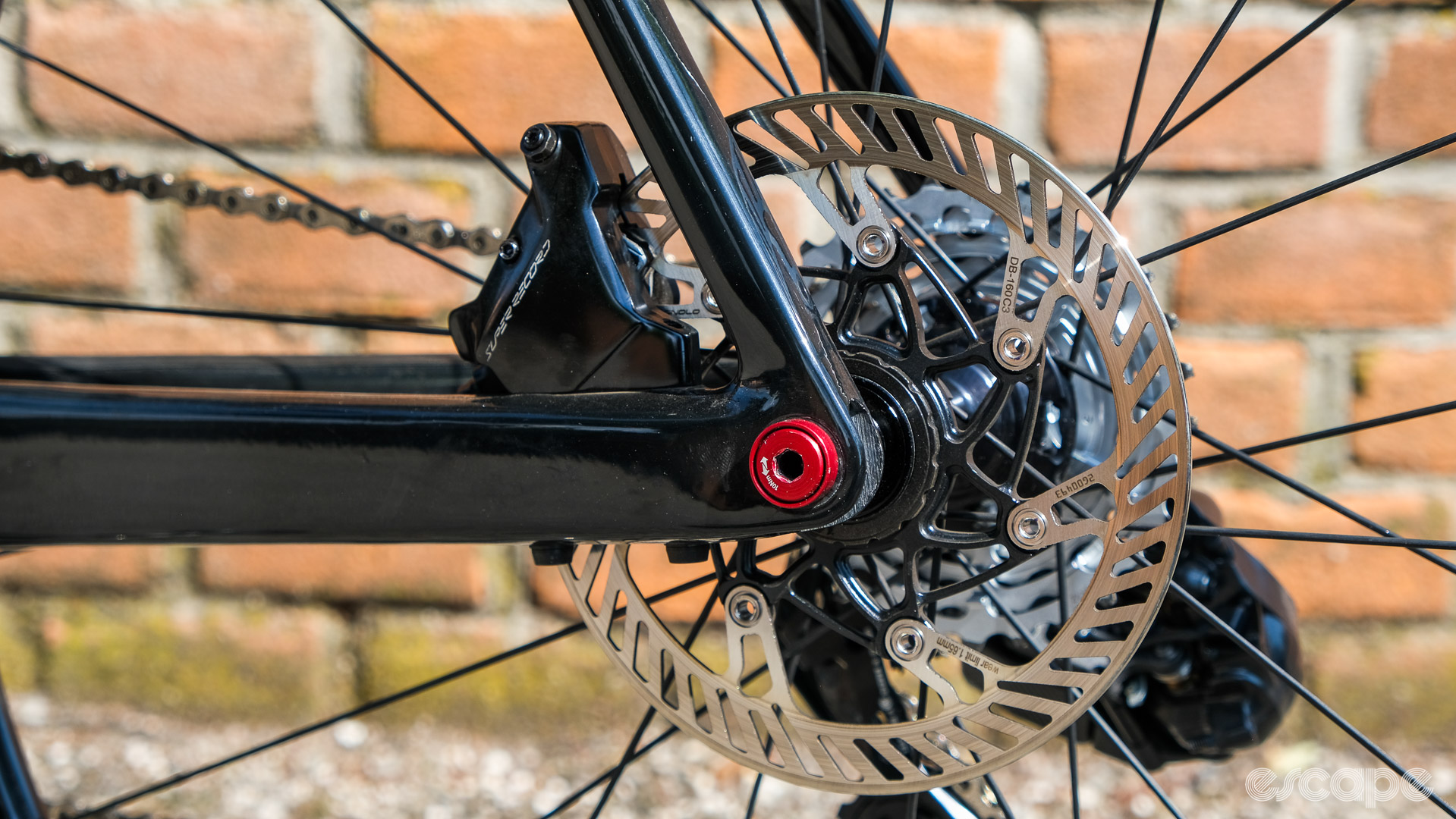
Same great brakes
Campagnolo's disc brakes are widely considered to be among the best on the market. The good news is the brakes here are mostly entirely a carryover item from Super Record EPS. Yes, there is a slight aesthetic and architectural update to the callipers, and the pads are now 30% lighter thanks to a new aluminium backing plate replacing the old steel version. Still, for the most part, the new brakes are identical to the current version.
Campagnolo claims the performance advantage here stems from its rotors. The wider rotors (1.85 mm rotor thickness) with rounded edges and a unique cutout profile are said to better control overheating and incorporate a patented and scientifically tested anti-cutting design. Remember those days when we all though disc rotors were like circular saws in the peloton?
In addition to this increased thickness (Shimano and SRAM rotors are a claimed 1.75 mm thick) and the unique cutout profile, Campagnolo points to the floating mounting points attaching the brake track to the carrier, with seven at front and six at the rear, as the secret to its braking performance. Specifically, those mounting points rock back and forth a little when cool and could be mistaken for a loose headset. But as the rotors heat under braking, they can expand a little, eliminating that movement but also reducing the risk of rotor overheating and warping.
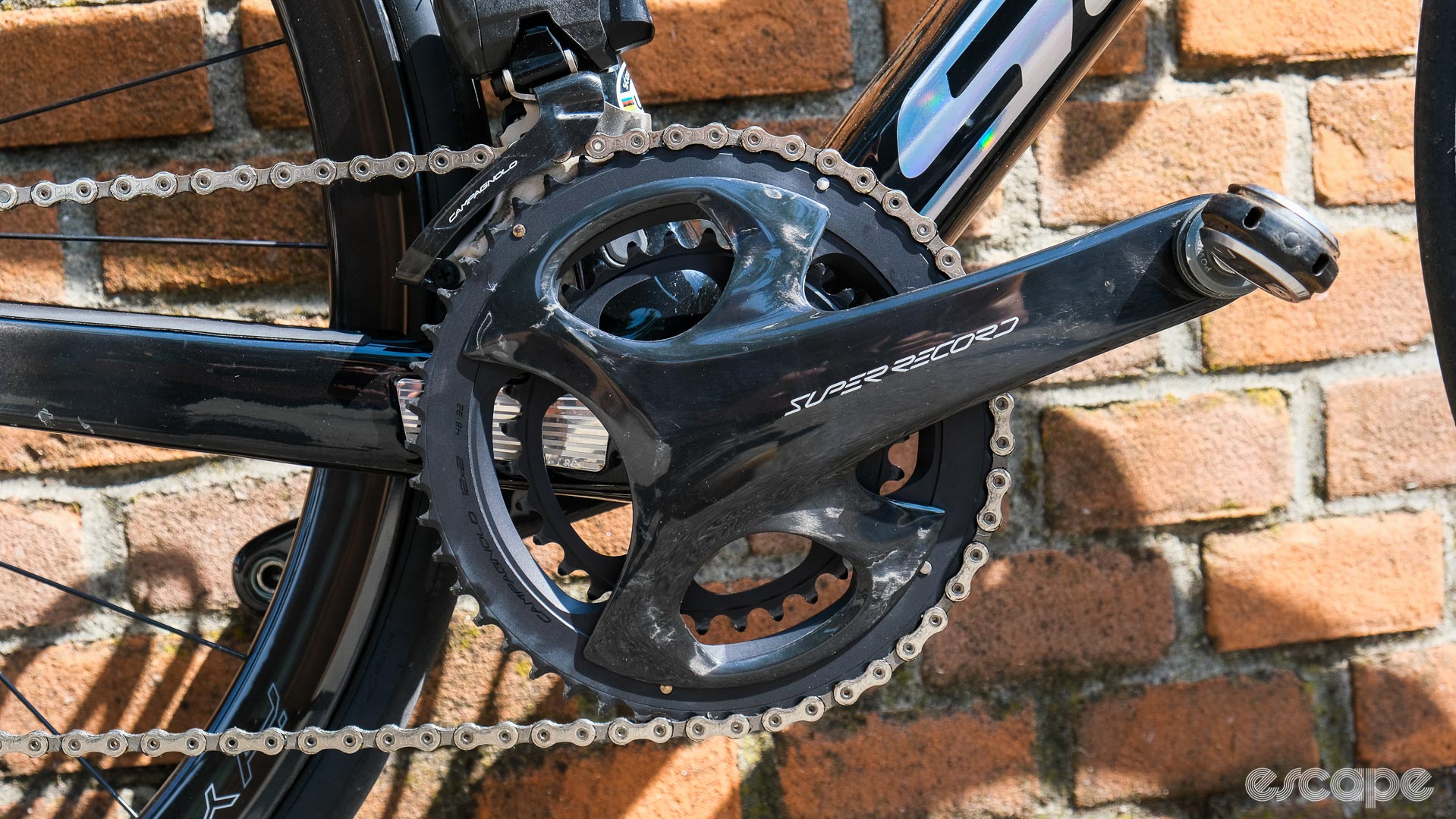
Newish cranks
Finally, we have the cranks. On the face of it, the new cranks look very similar to the current version. The sleek design, unidirectional carbon fibre crank arms, titanium axle and aluminium chainrings are all retained. So too is the carbon chainring bridge, Ultra-Torque bottom bracket, and Hirth joint spindle. But digging deeper, the new cranks are significantly different in a few key ways.
First, and of little consequence, the new crank arms are marginally slimmer. More importantly, the new cranks now house a smaller chainring BCD (Bolt Circle Diameter) to accommodate the new, smaller chainrings. This is bad news for anyone hoping to ignore Campagnolo's "reimagined gear ratio" and use the existing 12-speed 53:39 chainrings. It's also bad news for anyone hoping to run the new chainrings on an SRM or Power2Max power meter with Campagnolo crank arms – or any other crank, for that matter.
Of less annoyance to most, but in a move that will prove disappointing for some, the Q-factor on Campag's new Super Record cranks has grown from 145.5 mm Q-factor on the existing cranks to 147.5 mm. While still half a millimetre narrower than Dura Ace 12-speed cranks, it's now 3 mm wider than the equivalent SRAM Red crank.

One thing Campag hasn't changed yet, is the inclusion of a power meter. Campagnolo admitted they are working on a power meter, and both the new drive and non-drive side cranks include a filled-in area that may prove to be an opening for a power pod when that power meter offering does come. The good news is, judging by those pods on each crank, Campagnolo is working on a true dual-sided power meter. The bad news is, it obviously is not included in that already huge price tag.
Campagnolo has also integrated its Pro-Tech bottom bracket, first introduced with the Ekar gravel groupset, which is said to better protect against water and debris ingress.
Wireless wrenching
Mechanics the world over will celebrate the fact the new groupset is fully wireless. No one will miss fishing wires through frames – especially so with the Campagnolo EPS systems that had non-removable wires coming from the central power unit and stem interface, not to mention the fiddly access port under the hood in each shifter seemingly designed for three-handed humans.
Furthermore, while we didn't get to build or test the installation process, Campagnolo assures us the old zero setting initial install procedure is greatly simplified for SRW. The new process seemingly still requires the user to inform the system where the lowermost sprocket is, but from there, the brains within the derailleur works out the position of the remaining sprockets from that set point. There is still a low limit screw, just to be sure.

Not entirely in keeping with Campagnolo tradition, there are no new tools for assembling the new groupset. The chain is identical to that of the existing 12-speed and, as such, the current inside-out and pinning install process with the specific chain tool remains. But in even better news, Campagnolo has developed a 12-speed C-link (quick-link). Good news for any chain waxers, and that one shop owner who once told me, "here's your chain, you can install it yourself. At least then, if it's not done right and the chain breaks, it's not my fault."
Finally, the disc brake bleed kit is also unchanged. As is the three-year warranty period, although Campagnolo hinted at increasing this warranty at some point soon.
In total, Campagnolo claims the new groupset weighs in at 2,520 g, a 20 gram increase over claimed weight of 12-speed EPS. Campagnolo declined to provide weights for individual components, though we did ask. For comparison, Shimano claims its R9200 Dura-Ace groupset weighs 2,439 g, while SRAM states its Red AXS group is 2,518 g.
The groupset is available as of today through select retailers worldwide and a select few OEM suppliers with Canyon, De Rosa, and Specialized all name-checked in the presentation.
Unsurprisingly, today will also see the 12-speed EPS groupset disappear from the Campagnolo website, although you can expect stock and spare parts to remain for a while to come. What is less clear is the future of Campagnolo's mechanical offerings. As mentioned earlier, the new groupset is the beginning of the end for rim brake – there will be no rim brake wireless offering. The future of mechanical Super Record and Record is less clear, though. Officially both are still available, however, when pressed on the matter Campagnolo admitted their premium level mechanical groupsets are safe for the next 12 months or so, at which point "the market will decide."
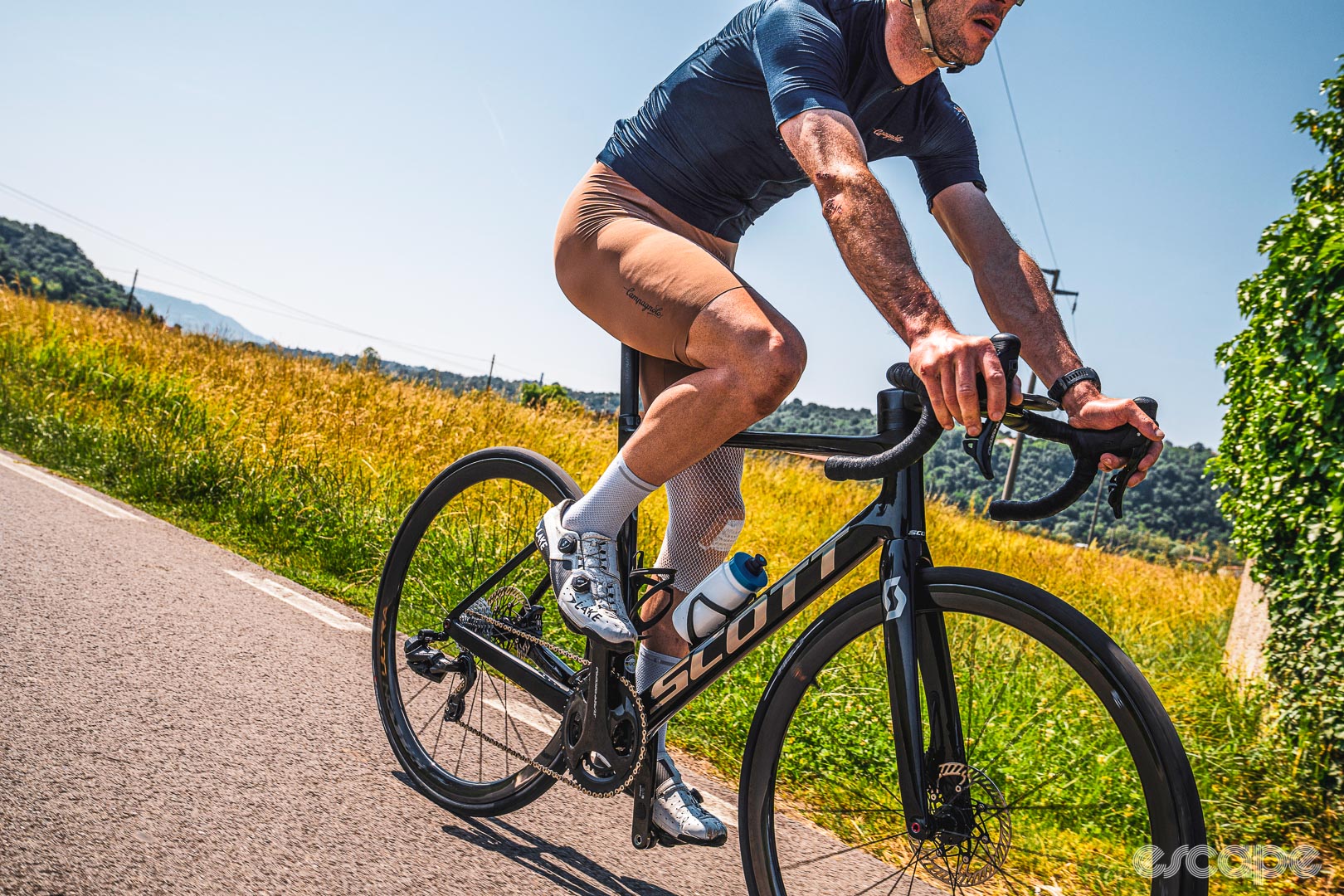
First ride review
So what's it like? Campagnolo invited Escape Collective to Vicenza for a closer look and a short ride with the new groupset. There was, of course, a detailed presentation of the new groupset and Campagnolo staff were on hand to answer a host of questions. However, more than the single 37 km ride we got with the new groupset is needed to fully assess Campagnolo's latest offering. With that in mind, this is very much a first impressions review of the new group.
Recent patent leaks and Instagram spoilers all but killed the element of surprise when it came to Campagnolo's big reveal. The new shifters are exactly as we see in the patent leaks and arguably far from Campagnolo's prettiest-ever offering.
The sheer size of the derailleurs didn't do much to set pulses racing either, while the cranks and callipers are effectively carryover items. Truth be told, the aesthetics of Campagnolo's 12-speed groupsets have never done it for me – certainly not in the way the circa 2014 11-speed Super Record RS or the mid-noughties 10-speed Record Carbon did. Those, like me, hoping for an exciting new step change in design philosophy will likely be left disappointed.
That said, in this instance, beauty is both a subjective and relative thing. Campagnolo, with all its carbon intricacy, still makes some of the best-looking of the current groupset offerings. Furthermore, what my 12-speed mechanical Record groupset lacks in sheer Italian elegance and form compared to the 10 and 11-speed generations, it more than makes up for in function. Can the new Super Record Wireless do the same?
The short answer from a short ride is – perhaps.
Let's start with the positive. I was pleasantly surprised with just how good the new, simpler-looking hood shape is. The new hoods are very simple, straight, and angular looking compared to almost everything else currently on the market at this price point. But as simple as they look, I found the ergonomics and general comfort superb.
The new wider, longer hoods offer a much more natural fit for my hands with no pressure points or gaps. Simple as they look, the new shifters felt considerably more comfortable than my 12-speed mechanical Record shifters. There's also more space on the underside of the lever body behind the brake lever, which allows for much better grip and as many as all four fingers to wrap around the lever body if desired.
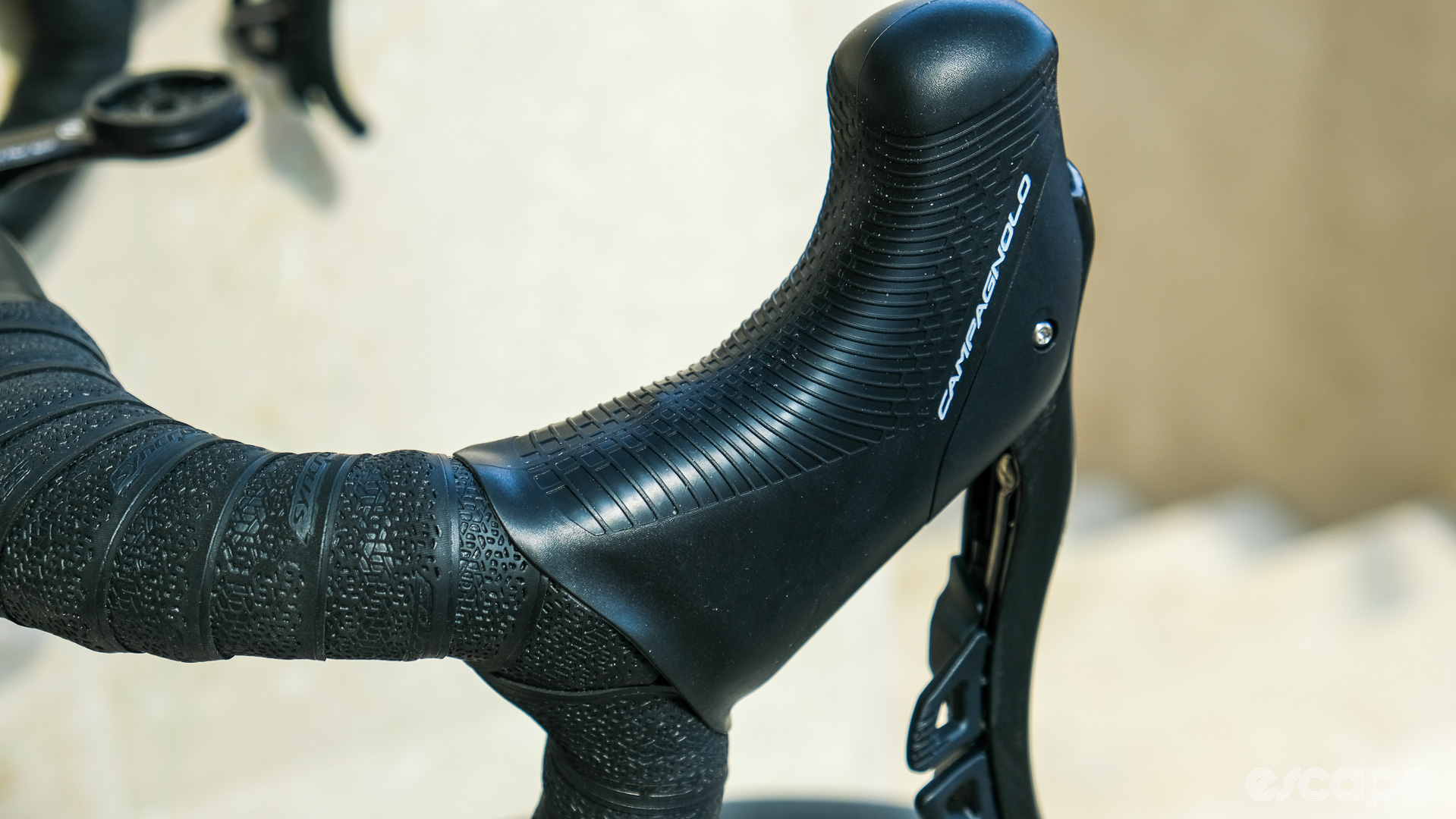
The new design looks much simpler, and only time will tell how well the design fits for a wider range of hand shapes and sizes, but it seems like Campag has once again redefined lever ergonomics. Even if our hands are still the same.
As mentioned earlier, the Campagnolo disc brakes considered by many as the best available. I'm happy to report the slight aesthetic and architectural changes to the calliper have had no impact on the stopping power and modulation. The brakes weren't broken, and Campag hasn't fixed them. Thank you.
Now the question on all our minds – what about the shifting and those new buttons? It's here the short ride on the new groupset left me less than convinced.
If I had a fiver for every time I hit the wrong button, I could almost afford this new groupset. Admittedly, it is a new design I've never tried before, and Campagnolo is adamant many riders had the same experience during testing before growing to like the new setup within a few rides.
That said, I routinely swap between Campy, Shimano, SRAM, and TT shifting setups regularly – sometimes riding all these within a few days – and I never have to give a second thought to which button to press; it all comes naturally and intuitively. Campagnolo claims its new design is just as intuitive, with the top button for upshifts and the bottom for down. Furthermore, Campag was keen to stress all the buttons are entirely customisable.
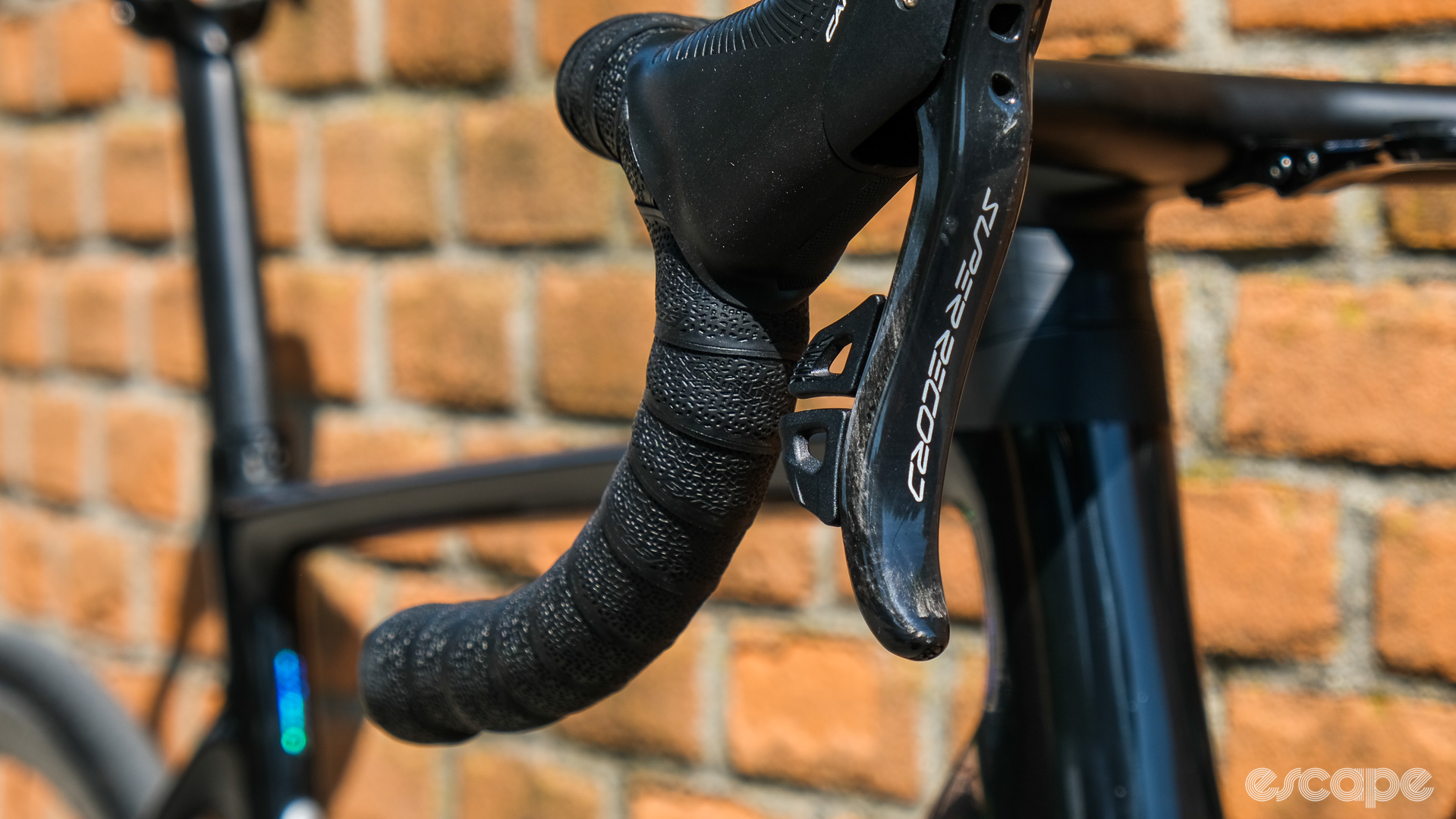
For me, though, I never got that intuitive feeling, although perhaps a few more rides could have helped. But even as a seasoned cyclist, I can't help but think the up, down, downshift, upshift, derailleurs moving left and right, and the chain moving up and down mismatch is a tough ask. I had to think about which button I needed for every shift, and, worse still, thinking about it felt like trying to tap my head and rub my stomach simultaneously.
That said, objectively, Campagnolo's new design is not all that different to Shimano's two-button Di2 design, and I got my head around that. Let's assume for a second, though, that I become more accustomed to the new setup with more time on the new groupset. I'm still not wholly convinced by it; the buttons are relatively small and stacked quite close together. The theory is the buttons are designed so that the rider's index finger operates the upper, while the middle finger operates the lower. Nice in theory, but again, I didn't find that natural out on the road.
Ultimately, though, it's accidental shifts I find more worrying. Riding in the drops, with fingers hovering over the brakes, as I often do in the middle of a bunch or peloton, I found the shift buttons aligned perfectly with my fingers. That's probably a good place for them, but sprinting out of one hairpin bend my fingers accidentally shifted me to the small chainring. A potentially catastrophic shift I've never experienced with any other groupset.
At the risk of sounding like an old curmudgeon, I can't see any benefit in dropping the thumb shifter. (I wasn't going to include this chapter, as clearly I am a biased thumb-shifting-lover, but hear me out.)
Throughout the presentation, Campagnolo repeatedly stressed the possibilities its MyCampy 3.0 app offers, especially in customising the button functionality. Riders can customise the new buttons to perform any function, and I get it – that's a good thing. But it's not new. The MyCampy app offered customisable shifting as far back as EPS V2. In fact, one of the best shifting setups I've ever tried was converting the Campagnolo levers to have the thumb shifters reserved for front derailleur shifting, and running the levers behind the brakes in a SRAM-style left-easier, right-harder gears. That setup made the Campagnolo shifting as intuitive as SRAM's almost universally approved setup, and reserved the thumb shifters – which some riders find more difficult to reach – for the much less frequently used front shifting. Furthermore, because those shift levers on Campagnolo shifters are independent of the brake lever, I could grasp the lever within my hands when in the drops and effectively enjoy a Grip Shift style setup which was fantastic for sprinting.
It seems to me Campagnolo has ditched an established and proven design, arguably even better suited to the electric group sets of today than the mechanical it originated with, in an attempt to attract a portion of the market it's unlikely to convert anyway. I get it, though – ditching the thumb shifter is an easier story to tell in attracting new Campagnolo customers and thumb-shifting-sceptics than convincing the same group of the value of customising their shifter functionality.
Unfortunately, the new buttons weren't the only thing leaving me with a lingering question mark. The shifting wasn't quite the Campagnolo I know.
General riding on the flat and upshifting through the lower single tooth jump sprockets sprinting out of corners was as sharp and crisp as you'd expect. The shifts are as fast, if not faster, than the new benchmark 12-speed Dura-Ace Di2 and the single-tooth jumps between lower sprockets, along with Campagnolo's legendary shifting, is a dream combination.
I was also pleasantly surprised by the system's ability to perform front and rear shifts almost simultaneously. Not quite as smooth as a mechanical Campag group, but a huge improvement in an area I felt the 11-speed EPS could have been much better. (Note: I haven't ridden 12-speed EPS.)
But our short ride left me with question marks on shifting through the larger sprockets with two and three tooth jumps, especially under bigger loads attacking uphill. The usual confidence-inspiring definitive clunk from Campag's shifting was more like a vague clunk with the new derailleur and cassette pairing. I'd find myself asking questions: 'Did I get the right shift?' 'Is the chain going to skip?'
Ultimately, the rear shifting didn't actually miss a beat, but it lacked the refined shifting experience in the larger rear sprockets I expect from Campagnolo. This was most evident on an uphill surge, in the big chainring and shifting through 26, 23, 20, and 18 sprockets at ~400 watts, as if attacking in a race, the definitive Campag shifting clunk was more like a harsh leg-sapping thud. Not great, but I would like to get more time on the groupset to see if this was a once-off on my heavy legs with a groupset that still needed the so-called Campagnolo wearing-in period before making a definitive call.
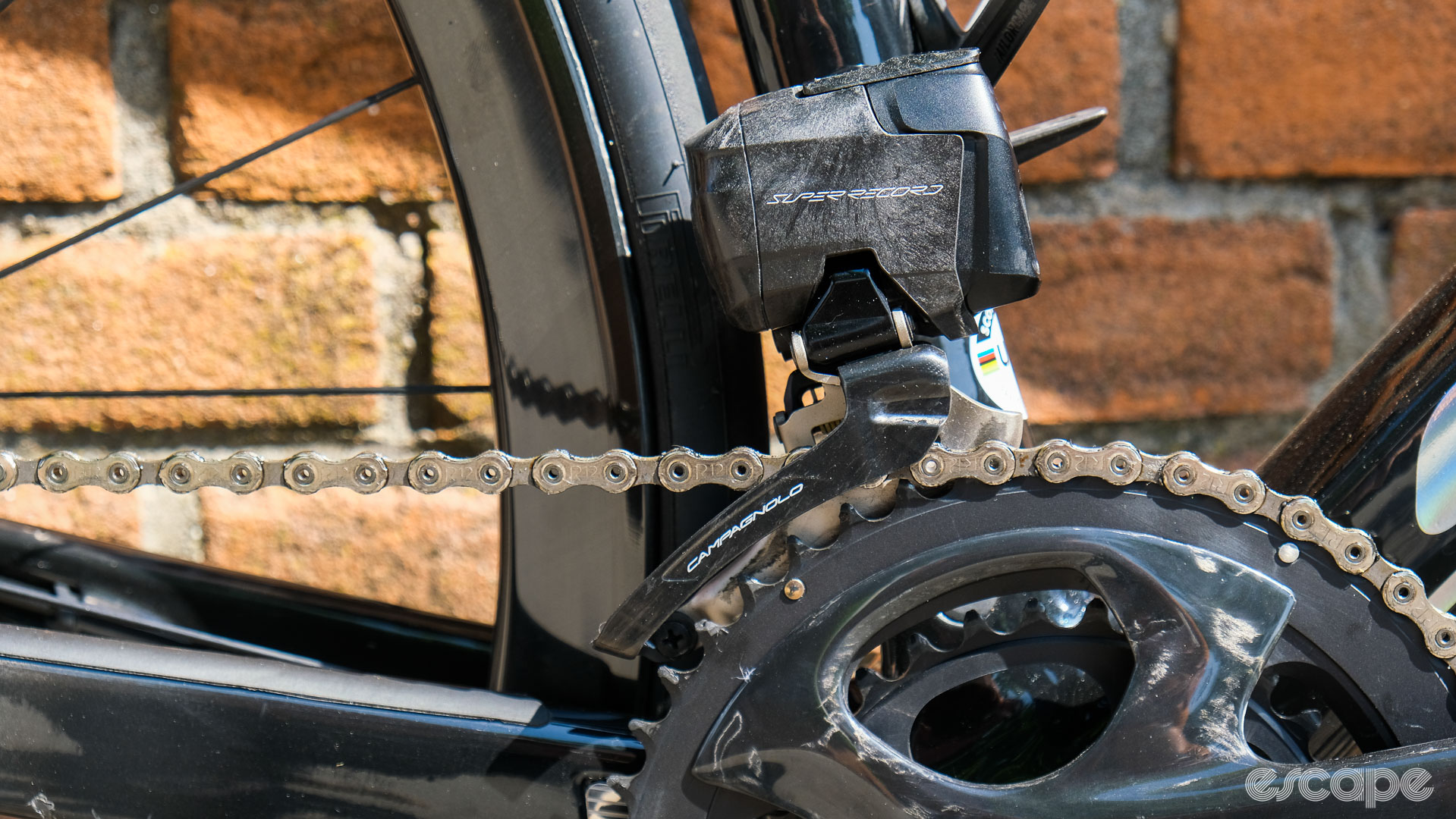
The front shifting left me with a few questions also. Getting silly with the front derailleur shifting up and down in quick succession, it performed flawlessly. But it did have some hesitation on a few shifts from smaller to bigger chainring, just cresting climbs under moderate load and the slower cadences typical of that scenario. Again, the shift happened, and it never dropped a chain, but equally, it was far from as smooth as some competitors' offerings.
The multi-shift is also extremely sensitive – shifting what felt like twice as many sprockets as intended was too easy. Not only did it not match the multi-shift from other brands, but the time pressing the button didn't correlate in my mind with the number of shifts performed at the rear. Again, this is probably something that simply takes a few rides to accustom to, and is adjustable in the MyCampy app.
To be fair, knowing I just had one short ride inevitably had me trying to test as much as possible, rather than just ride how I normally would. I likened this to some test drives with customers back in my days as a car salesman. Often you'd have customers test drive as if it was a rally special stage on the WRC. To address such needlessly reckless driving, I'd usually mention to the potential customer that I was happy for them to drive as they wish, but they might get more value in testing how the car will feel for their everyday driving.
The times when I managed to forget myself and just ride the way I would do most days, the new groupset disappeared into my subconscious, and that's a good thing. But reminding myself I had to get a feel for the new group and doing silly test drive rallying, almost trying to exacerbate any flaws, did throw up these few concerns I have highlighted.
Elephant in the room
Then there is the price. At US$5,399 / £4,499 / €5,200, what can we say about a groupset that costs as much as an electronic groupset-equipped carbon road bike with carbon wheels? Campagnolo has always cost more – it's made in Europe, presumably operates with smaller volume, and is undoubtedly the most premium groupset offering. Campagnolo fans could justify the increased cost with the brand's racing DNA, performance focus, durability and beautiful styling.
We shouldn't be surprised, though. In an ever more ludicrously priced market, Campagnolo had to make another leap into the pricing stratosphere to retain Super Record's ultra-premium position. It's Campagnolo's fans who will suffer, though. This considerable price hike comes to what was already the most expensive groupset on the market, and will prove a hurdle too high for many Campagnolo fans, many of whom will now be hoping a Record or Chorus level wireless groupset follows soon. The good news is that company spokespeople did hint that a lower spec groupset is in the works and will be "different again" when it finally arrives.
So the new Campagnolo Super Record Wireless is finally here. As impressive as it looks with its sweeping lines and sleek carbon finish, my first ride leaves a few question marks. A longer-term review will answer the performance-related questions, but others remain.
Will ditching the thumb shifter attract new customers? When will a Record or Chorus level wireless groupset appear? What about additional cassette and 1X chainring options for increased gravel versatility? Only time will tell, although Campagnolo did say it believes mechanical shifting is still the best path for its gravel offering.
Whatever the answer to those questions, the new Super Record Wireless groupset – and its pricing – reaffirms Campagnolo's commitment to making the most premium groupsets on the market.


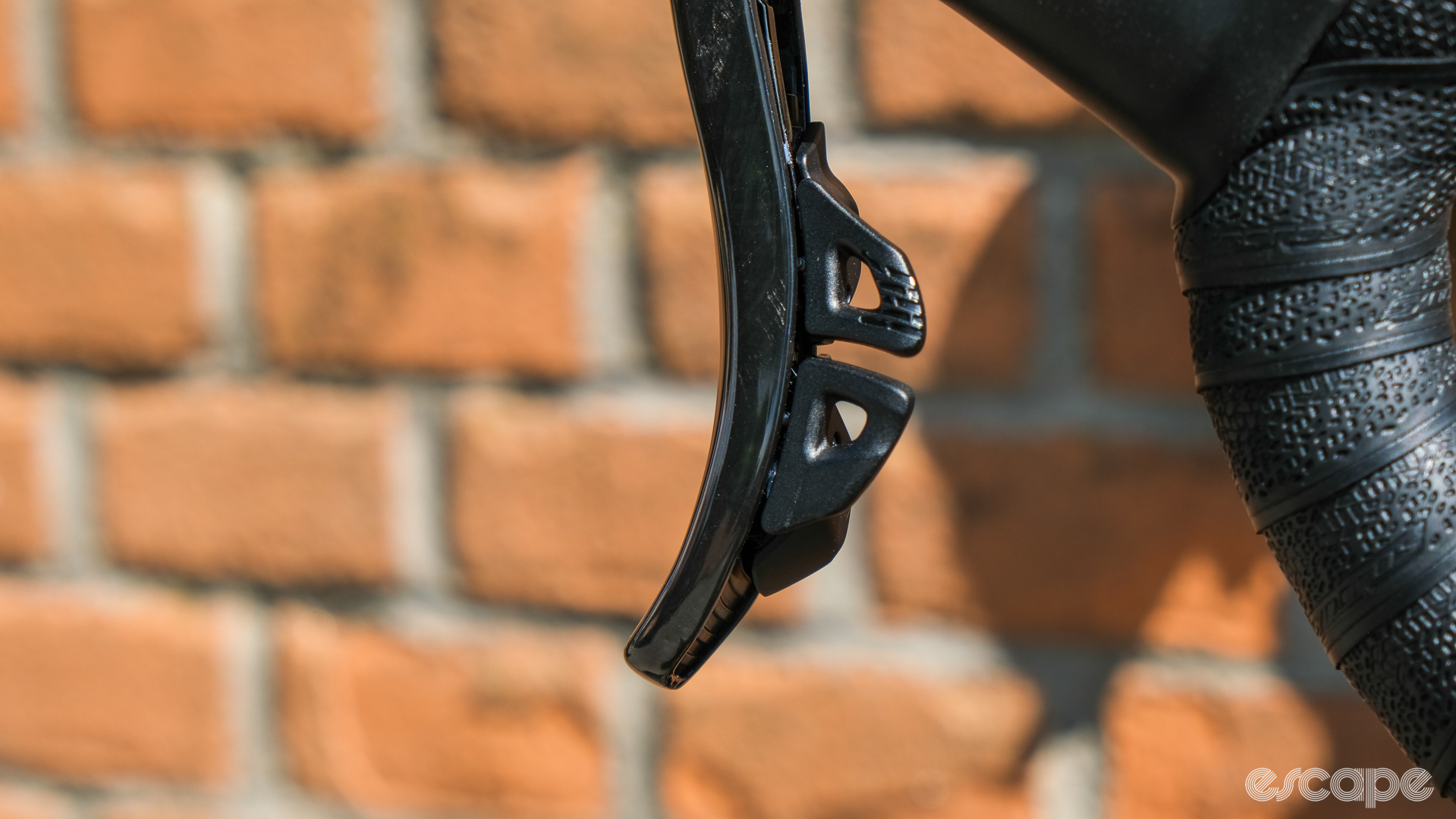
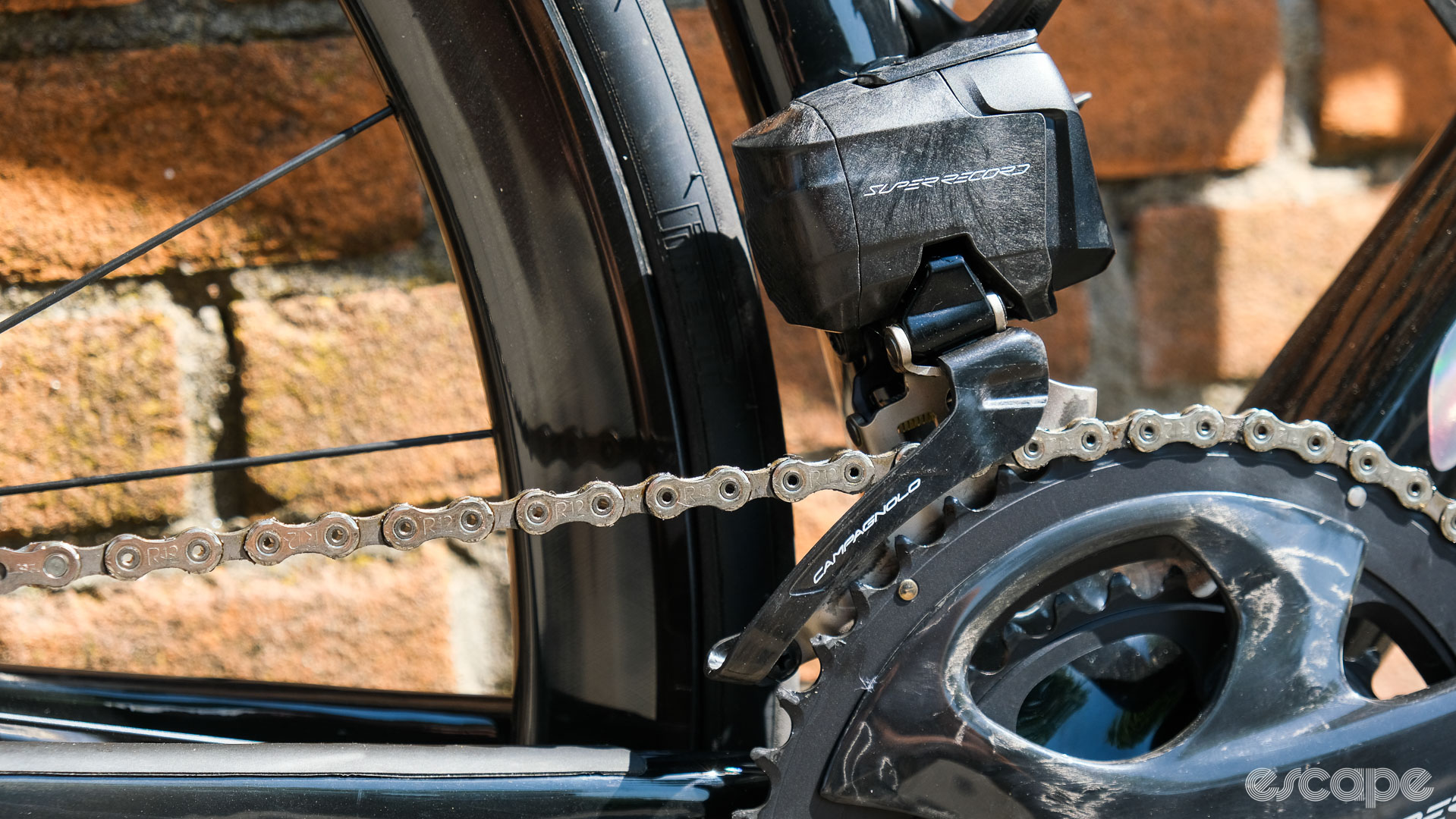
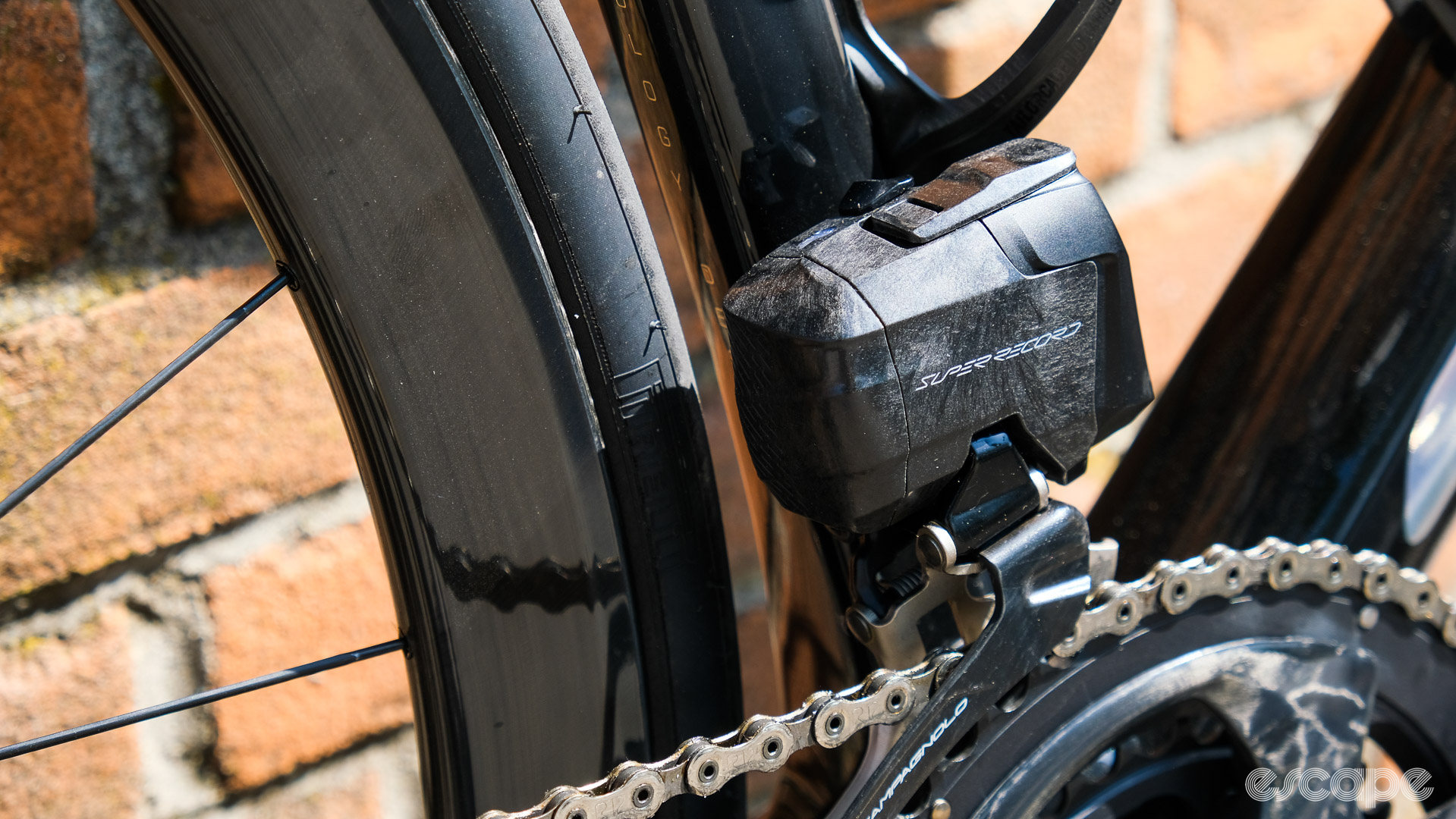
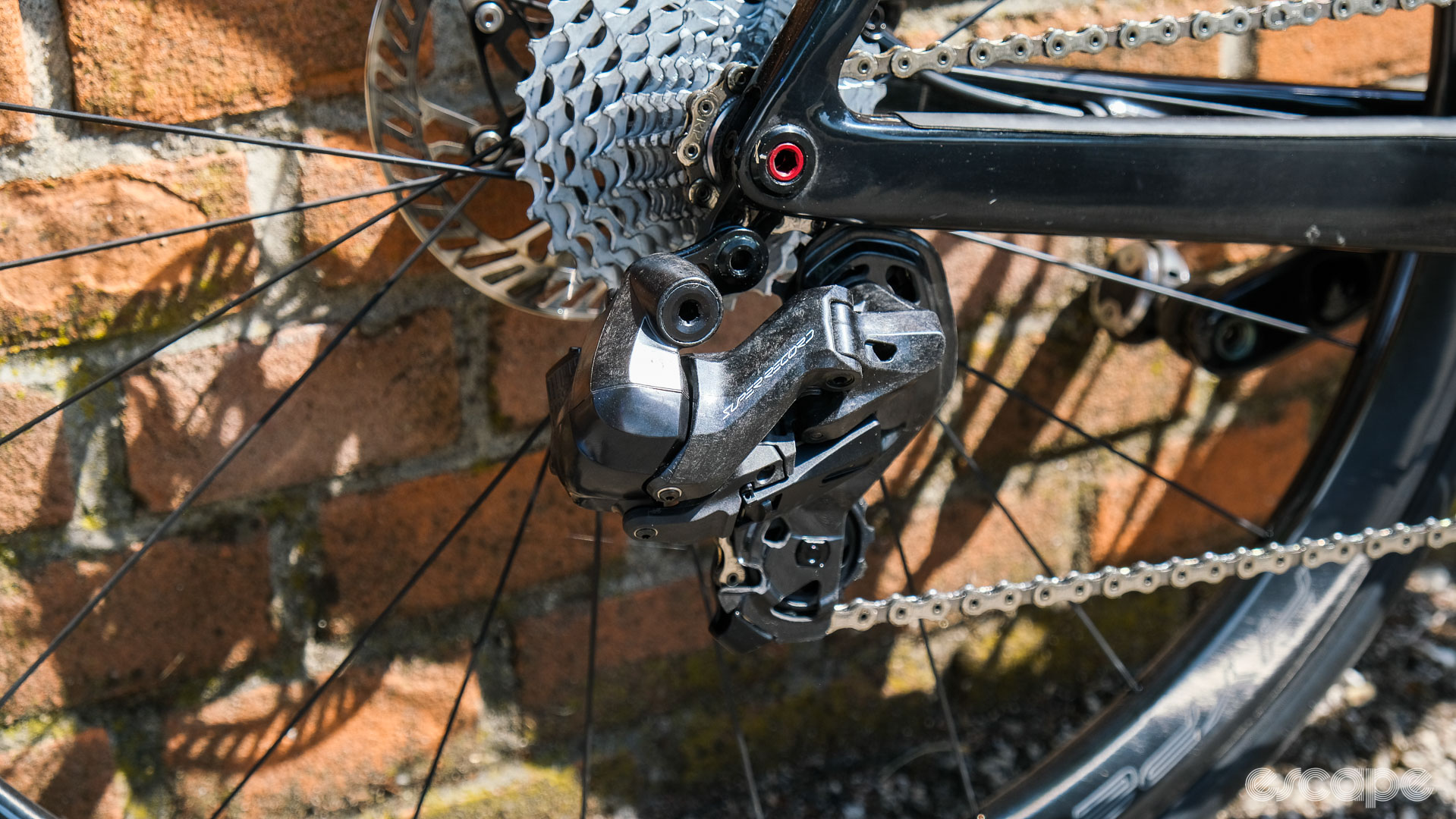

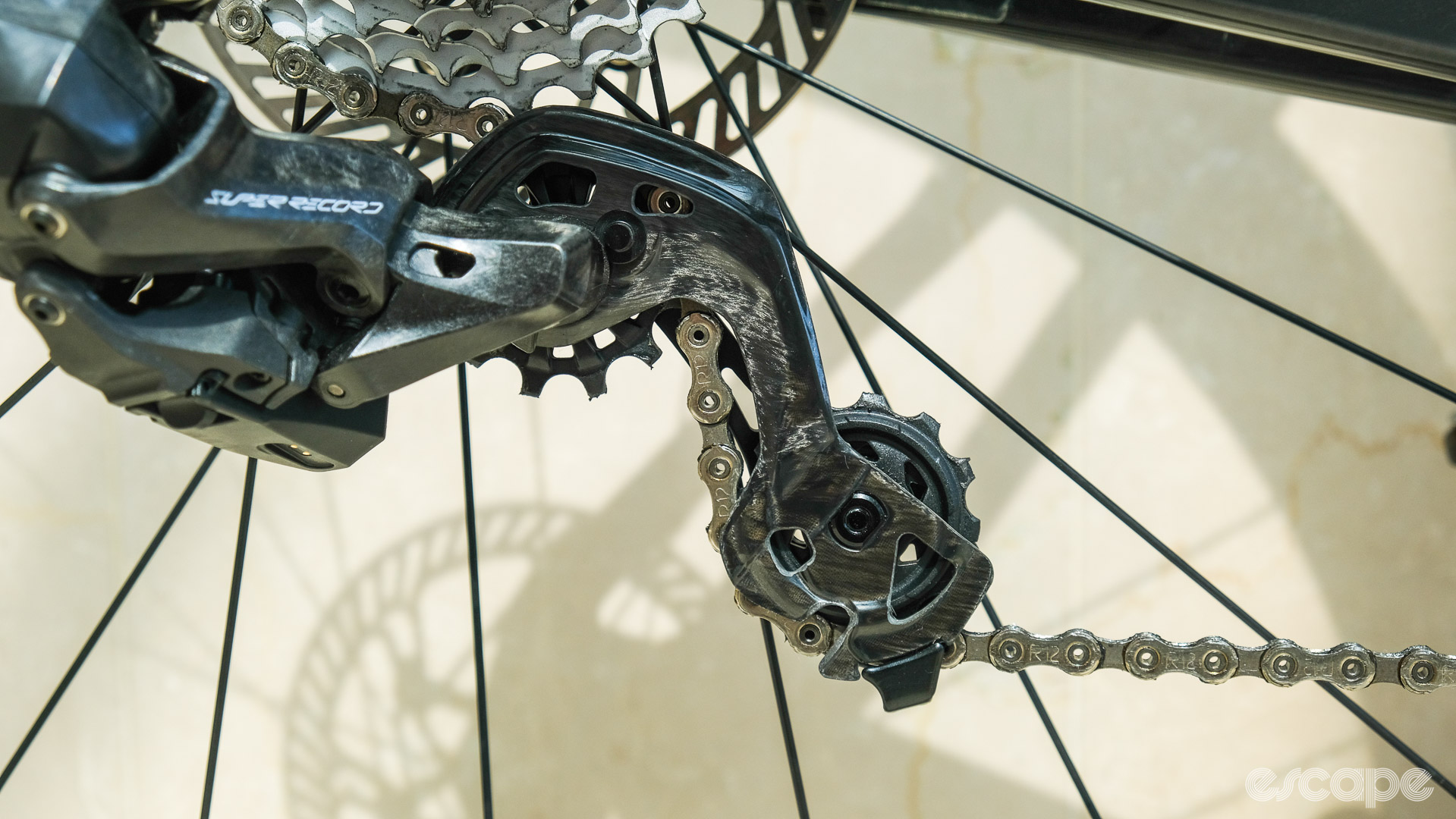
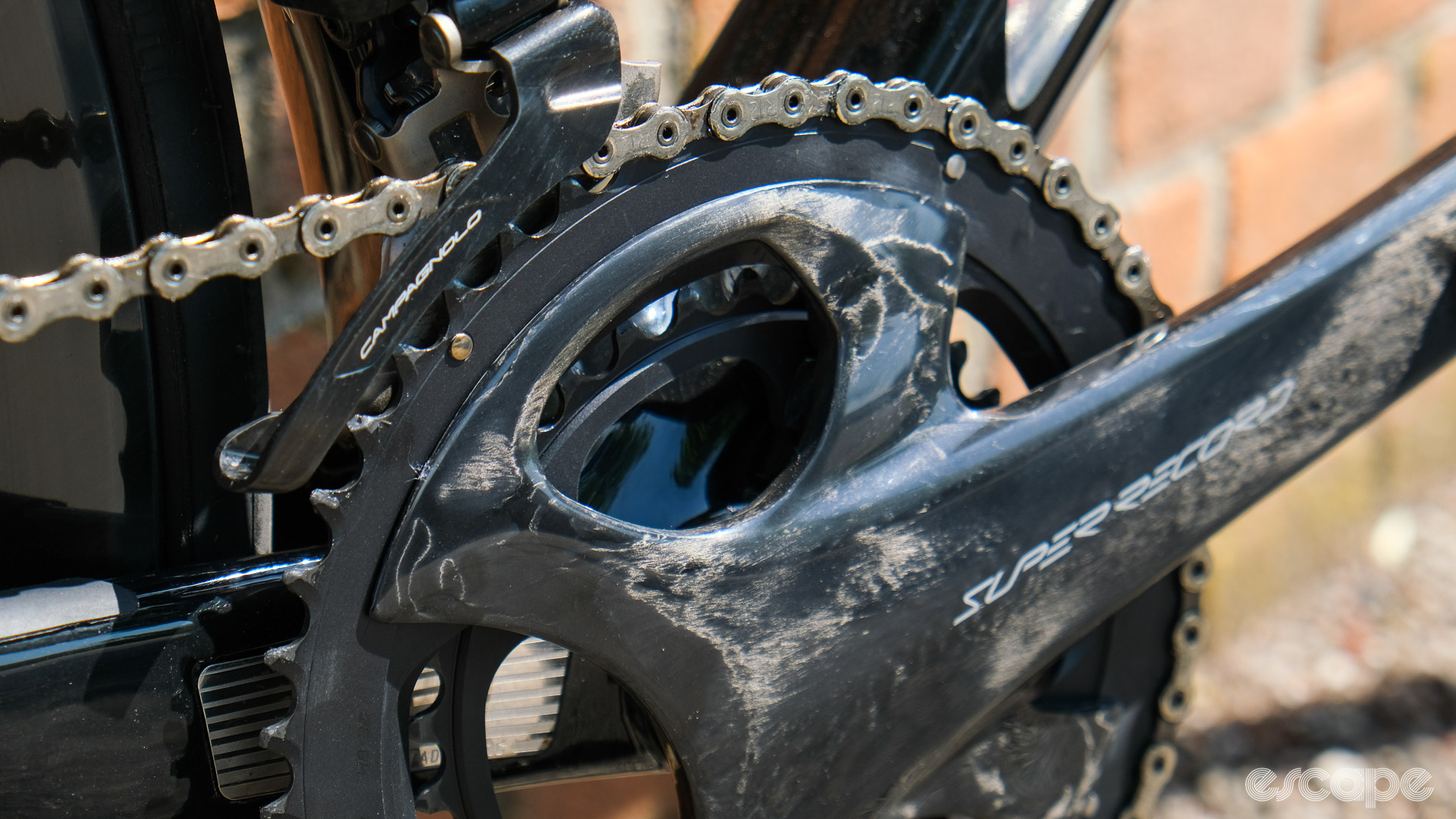
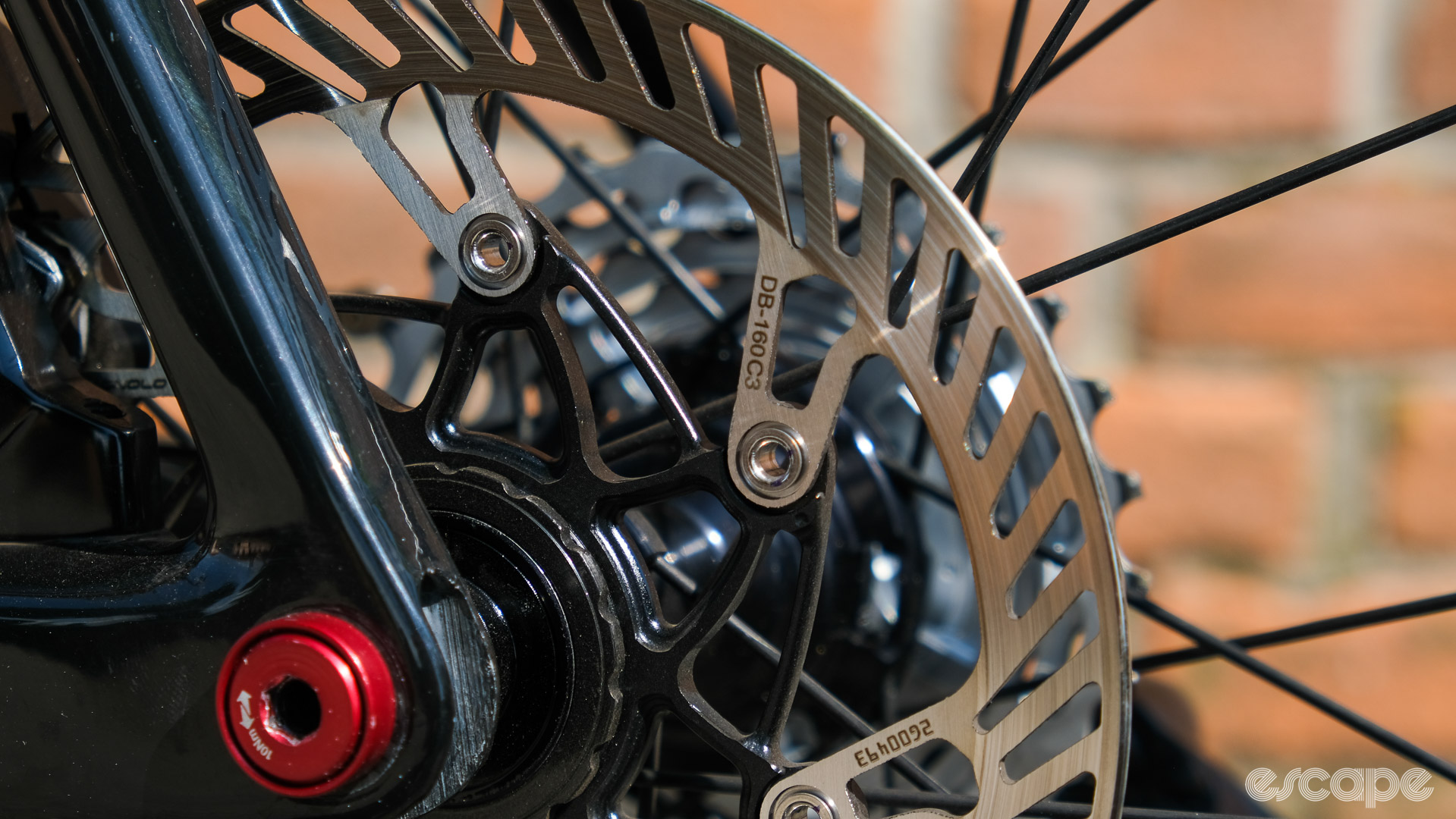
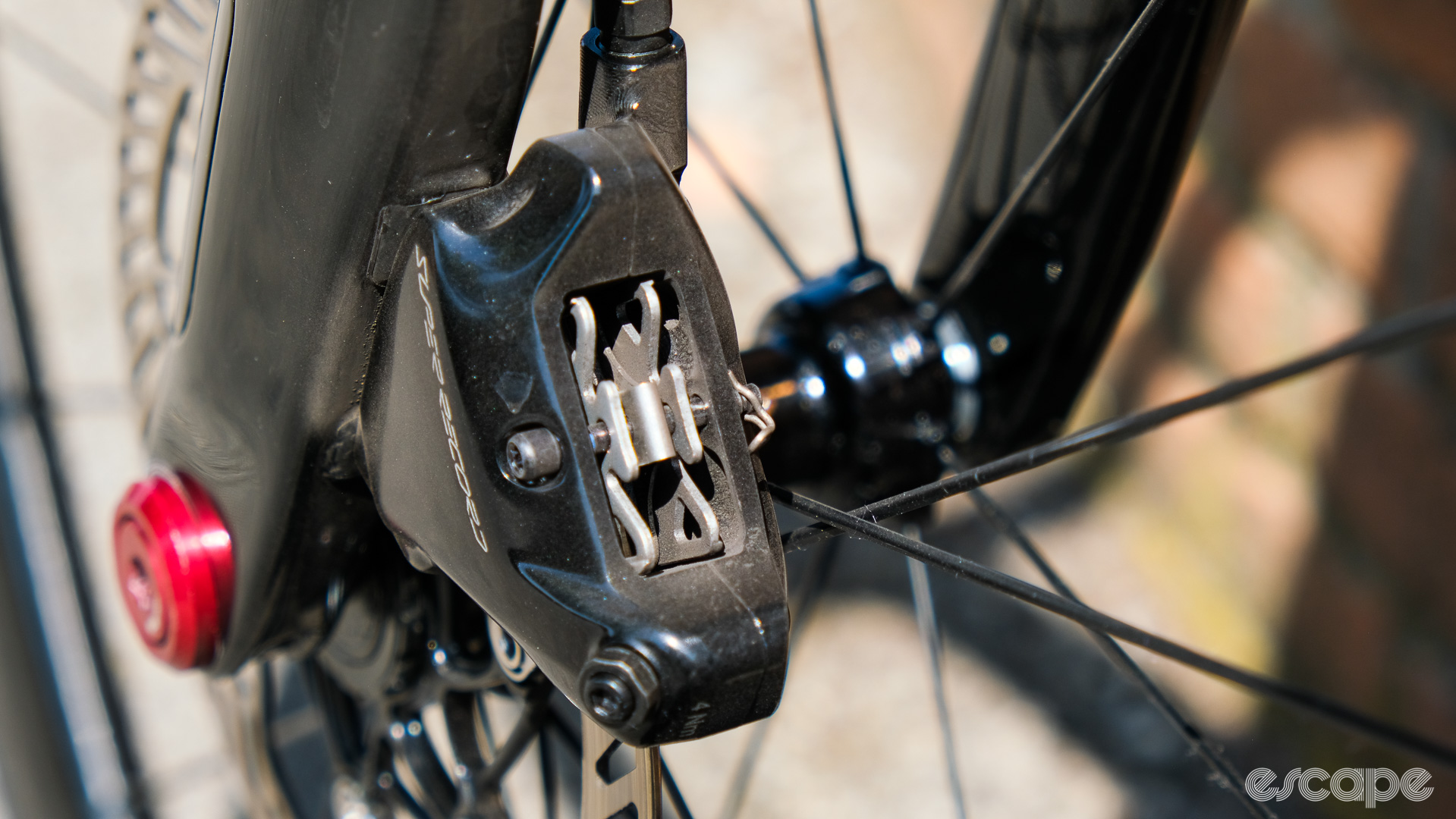
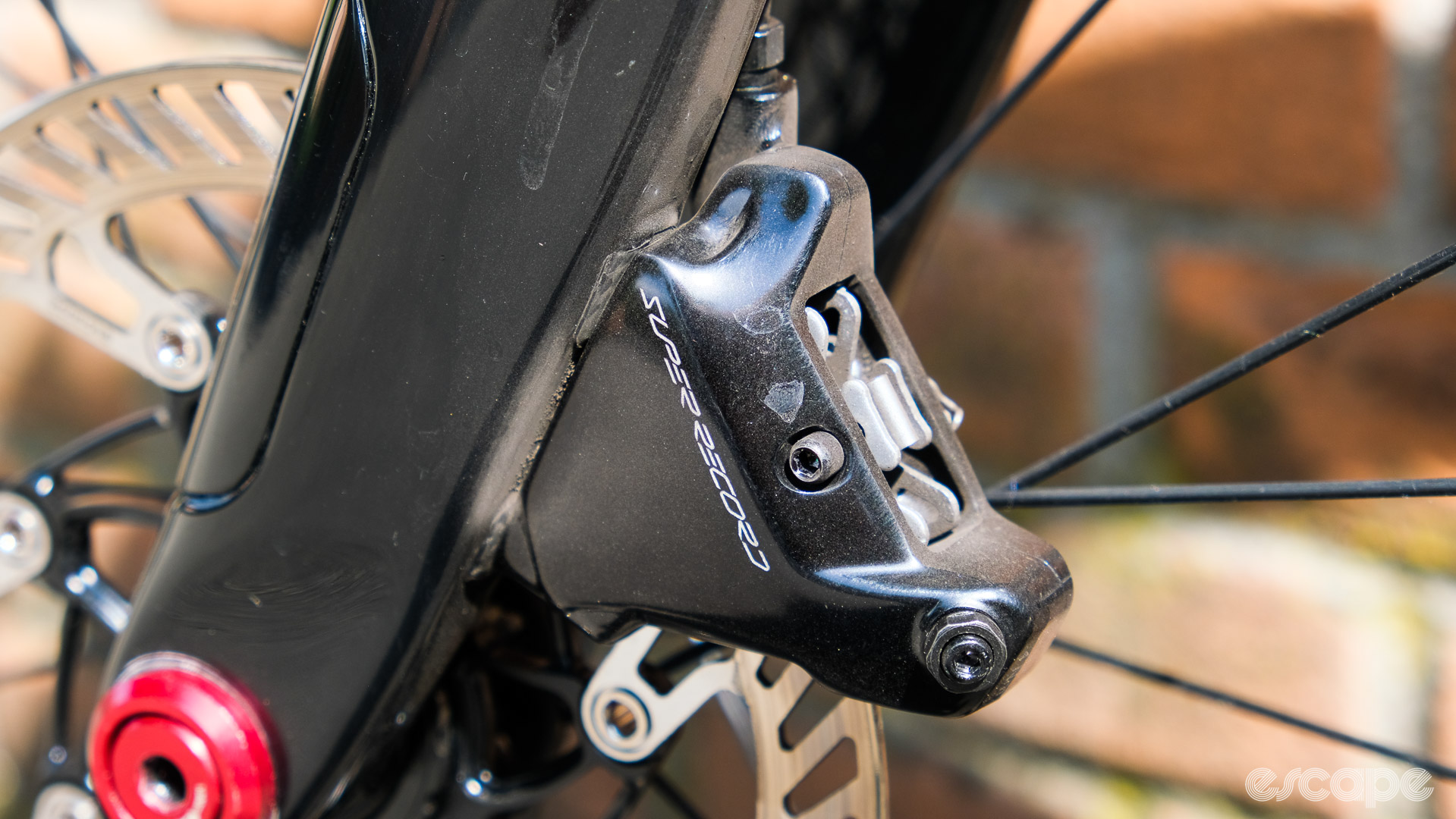
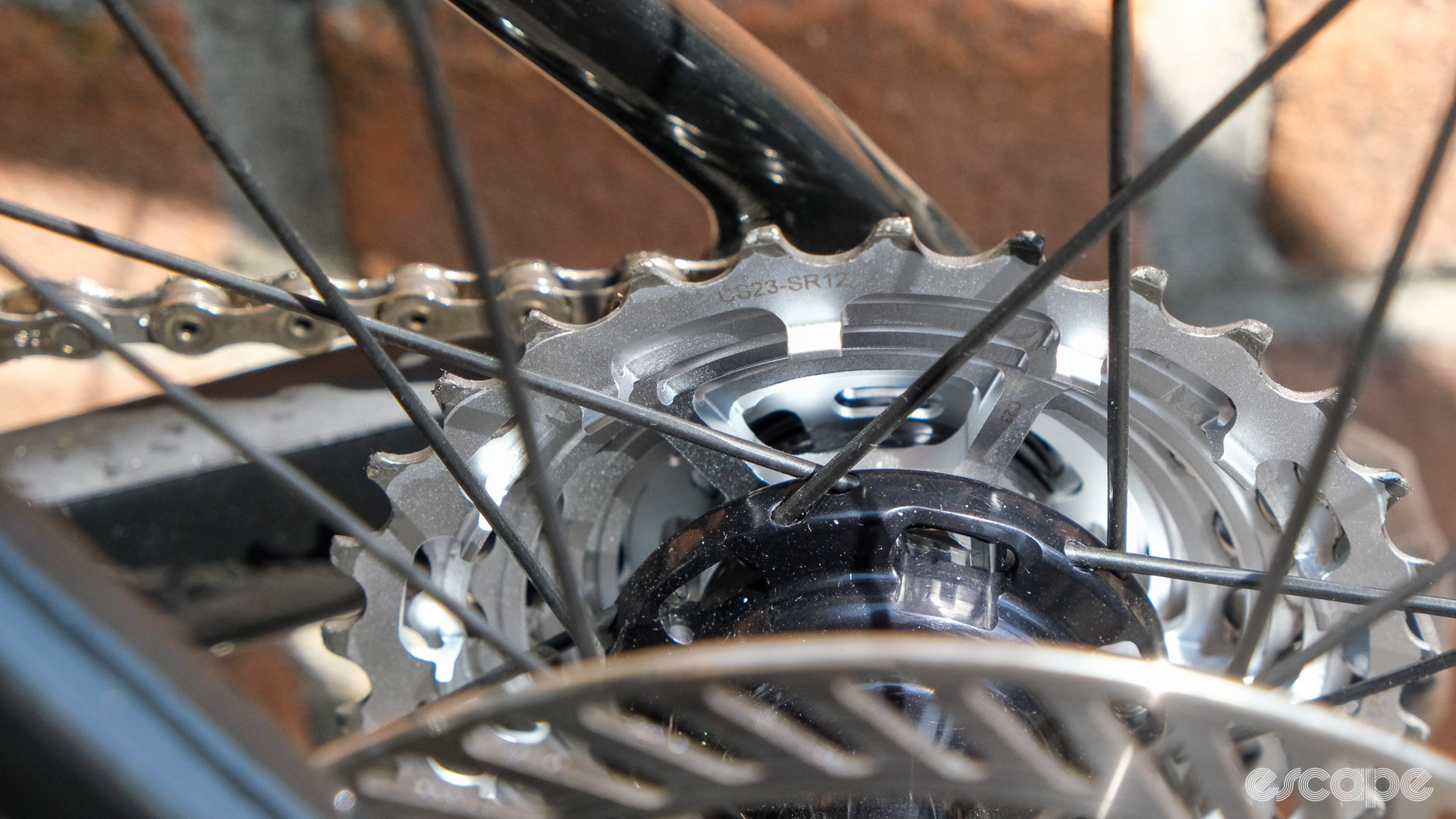
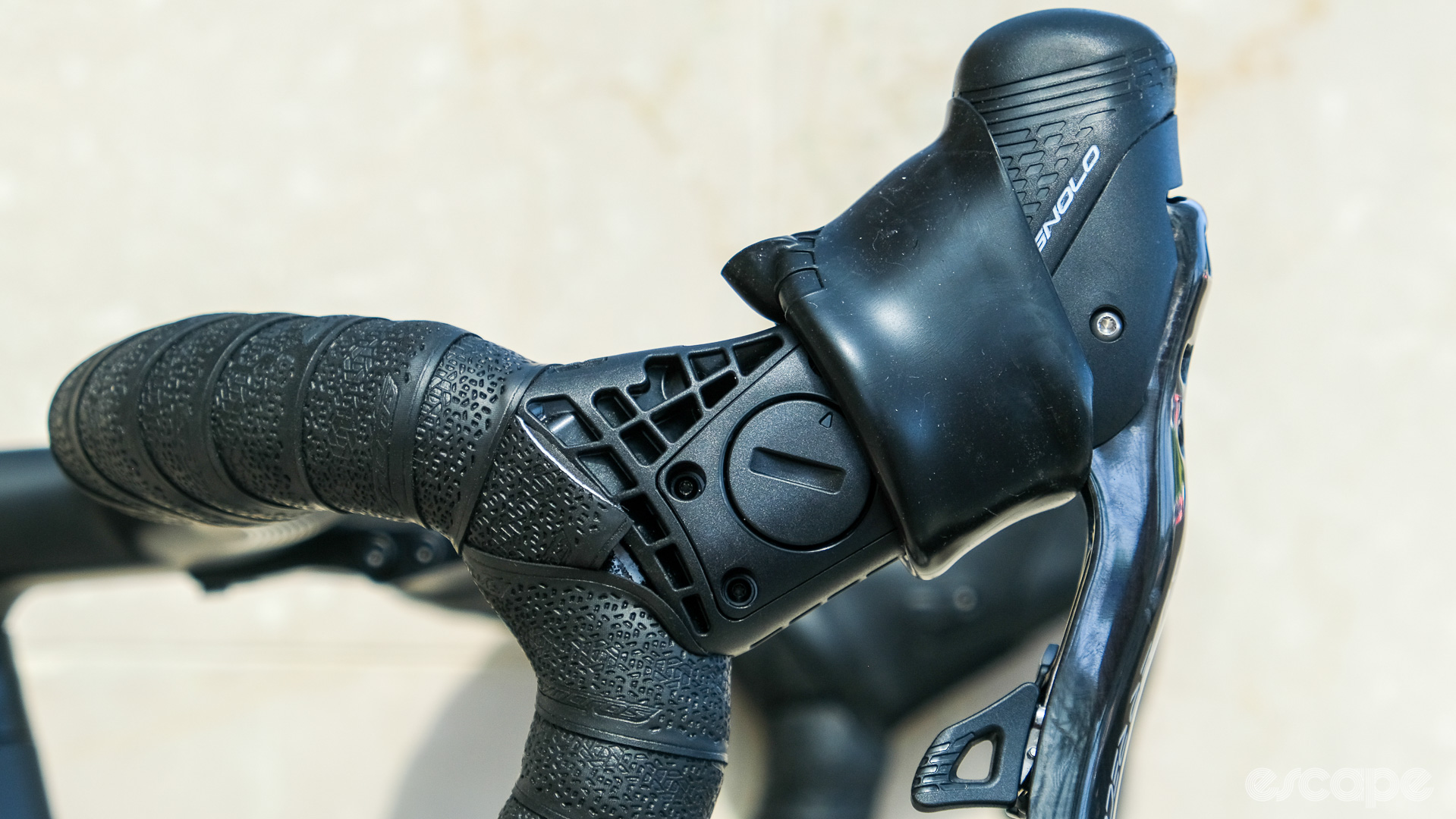
Did we do a good job with this story?

